November 29, 2013
Early Opera Company: Acis and Galatea
This vibrant, stylish performance by the Early Opera Company, under the direction of Christian Curnyn, left us in no doubt as to why it was one of the few of Handel’s large-scale works to remain popular after the composer’s death. As the drama swiftly unfolded, the stream of glorious melodies rang forth one after the other, spanning the full dramatic gamut from elation to despair, from fury to resignation.
The first performance of the work in 1718 was a private one, at James Brydges’ elegant house, Cannons, where Handel had been fortunate to gain employment following the closure of the King’s Theatre in 1717. Described as a ‘masque’, Acis and Galatea is typical of the short works on pastoral or mythological subjects which represented a home-grown ‘rejoinder’ in the face of the increasing public taste for Italian opera during the early eighteenth century.
The libretto — which was probably co-authored by John Gay, Alexander Pope and John Hughes — is drawn from Dryden’s translation of the thirteenth book of Ovid’s Metamorphoses, which appeared in London in 1717. It depicts a romance which unites earthly and immortal realms. The sea nymph Galatea is pining for her beloved, Acis; unbeknown to her, the young shepherd is simultaneously searching for her, anxious to be reunited with his cherished Galatea. The rational, worldly-wise Damon warns Acis that he is neglecting his duties, but the impetuous shepherd heeds not his friend, and eventually the lovers are reunited. However, the arrival of the love-struck monster Polyphemus soon spoils the celebrations, for the giant demands that Galatea transfer her affections to himself; when she refuses and Acis rises in fury against the giant, Polyphemus crushes Acis to death under a boulder. Distraught, Galatea is reminded of her divine powers: she transforms the dead Acis into a stream, thus granting him immortality.
Christian Curnyn launched into the overture with verve, the dynamic, animated playing of the instrumentalists setting the high standard of playing that was sustained throughout the evening and establishing a gripping dramatic momentum. Ensemble was exemplary, and the stylish execution, full of intensity but always elegant, was impressive, as the players painted an Arcadian scene.
The influence of Purcell, especially Dido and Aeneas, is evident in the way in which the chorus is intimately involved in the drama. On the rather crowded Wigmore Hall platform, the five singers were seated behind the instrumentalists, forming a well-blended chorus from which they emerged to take their solo roles, thereby both participating in and reflecting on the action.
The opening chorus instituted the mood of Arcadian serenity, the five voices intermingling with ease and simplicity, initially creating a sense of breadth, before the introduction of some relaxed counterpoint and points of imitation. In contrast, ‘Wretched lovers!’, which commences Act 2 was full of foreboding, and in the unaccompanied lament, ‘Mourn all ye muses’, sung over the body of the slain Acis, the consort of voices was touching but not sentimental, particularly at the line, ‘The gentle Acis is no more’.
The soloists were uniformly excellent.
As Galatea, Sophie Bevan produced a luscious Italianate cantilena, her gorgeous tone resonating sensuously throughout the hall. In ‘Hush ye pretty warbling choir’, her nimble vocal line melded sweetly with the sopranino recorder and upper strings. Handel’s technical challenges presented no problem for Bevan: trills were neat, ornaments not excessive. The recitative which precedes her aria of mourning, ‘Heart, the seat of soft desire’, was poignant, and her subsequent earnest command, ‘Rock, thy hollow womb disclose! The bubbling fountain!’ consoling; while the line ‘Lo! it flows’, suggested a touchingly hesitant joy. In this final aria, the sparkling treble recorders of Ian Wilson and Hannah McLaughin, accompanied by mellifluous, undulating strings, wonderfully evoked the magic of the fountain into which Acis has metamorphosed.
Robert Murray demonstrated a lovely sense of line as Acis. He made much of what is essential quite a weak role dramatically, combining passion and lyricism, both assertive and elegant. ‘Where shall I seek the maiden fair?’ was full of the naïve haste of youth; in the second Act, Murray skilfully suggested the shepherd’s growing emotional maturity, shaping the dynamic rises in ‘Love sounds th'alarm’ with intelligence and craftsmanship. His penetrating melody was gratifyingly complemented by Katharina Spreckelsen superb oboe playing.
As Damon, Samuel Boden’s graceful, light tenor provided a pleasing contrast to Murray’s more ardent tone. Boden captured well Damon’s composure and wisdom; ‘Consider, fond Shepard’, in which he attempts to quell Acis’s jealous anger had elegance and presence. Boden sang with sweet, refined tone, especially in an eloquent ‘Consider, fond shepherd’. ‘Would you gain the tender creature’ — an appeal to Polyphemus to essay a gentler line of seduction — would surely have charmed anyone but this unfeeling brute.
To lose one villain was unfortunate, but to lose two could have been potentially disastrous, had Matthew Rose not been available to step into the breach when first Derek Welton, and then his replacement Ashley Riches, were unable to perform the role of Polyphemus. From his first utterance, ‘I rage, I melt, I burn’, Rose filled the auditorium with a rich and profoundly satisfying sound.
Both fearsome and grotesque, in this opening accompanied recitative and throughout the opera he conveyed the essential complexity of the role: are we supposed to laugh at the lovelorn ogre whose gauche compliments and endearments fail to impress, or to protest at his vicious, petulant cruelty which shatters the lovers’ harmony? Probably both; and, in the following aria, ‘O ruddier than the cherry’, Rose conveyed the immensity of the Cyclopean monster’s burning love for Galatea and his fiery hatred for Acis.
Ian Wilson’s delightfully sprightly recorder obbligato reminded us of Ovid’s humorous depiction of Polyphemus as a ferocious goliath who plays an outsized set of shepherd’s pipes! Polyphemus is the dramatic catalyst, disrupting the Elysian bliss, and Rose’s ferocious interjections in the peaceful duet, ‘The flocks shall leave the mountains’, brutally shattered the lovers’ calm avowals of constancy and steadfastness. Curnyn and his performers were justifiably radiant as they acknowledged the appreciative and heartfelt applause. This was a fantastic, engaging performance with not a single weak link. A fabulous evening.
Claire Seymour
Cast and production information:
Robert Murray, tenor (as Acis); Sophie Bevan, soprano (as Galatea); Samuel Boden, tenor (as Damon); Matthew Rose, baritone (as Polyphemus); David de Winter, tenor (as Coridon); Christian Curnyn, director, harpsichord. Wigmore Hall, London, 27th November 2013.
image=http://www.operatoday.com/Sophie_Bevan_Ahlburg.gif image_description=Sophie Bevan [Photo © Sussie Ahlburg] product=yes product_title=Early Opera Company: Acis and Galatea product_by=A review by Claire Seymour product_id=Above: Sophie Bevan [Photo © Sussie Ahlburg]November 27, 2013
Werner Güra Lieder recital, Wigmore Hall
The poems are united into a coherent whole by their varied presentations of the theme of love, as expressed through imagery of the natural world, and by the continuity of the musical form - each song moving to the next without a break, creating an integrated, progressive structure.
Güra, accompanied by his frequent partner, pianist Christoph Berner, is an affable, relaxed performer. He did not sing from memory, but was poised and by no means bound to the score. Yet, despite his unperturbed manner, clean delivery and good projection, the opening songs of Beethoven’s cycle were not fully assured. The tone was somewhat unfocused, the intonation occasionally imprecise, especially as he moved to a higher register, and at times he struggling to sustain a smooth melodic line. There was certainly a clear response to the text of the opening song, ‘Auf dem Hügel sitz ich’ (I sit on the hill): ‘Wo ich dich, Geliebte, fand’ (where, my love, I first found you) was sweetly floated, there was urgency in the line, ‘Weit bin ich von dir geschieden’ (Now I’m far from you), and a sensitive rubato elongated ‘Die dir klagen meine Pein!’ ([songs] that speak to you of my distress). But, Güra’s diction was not always as crisp as might have been expected from a native German speaker. Berner effectively shaped the inter-verse commentaries, finding a range of colours and moods.
The eerie monotone in the middle of the subsequent song, ‘Wo die Berge so blau’ (Where the blue mountains) was more steady, however; hushed and full of longing, the tenor’s whispered phrases preceded the fresh energy and accelerando which embodied the poet-speaker’s rising passion at the close of the song.
Berner’s dancing triplet semiquavers captured the lightness of the airborne clouds in ‘Leichte Segler in den Höhen’ (Light clouds sailing on high); and, the performers controlled the varying tempi effectively to convey both the fleetness of the soft west winds and the rippling brook and the mournful lassitude of the poet’s melancholy.
The ornamental flourishes in the accompaniment to ‘Es kehret der Maien’ were similarly buoyant and playful, crisply articulating the babblings of the brook and the dips and arcs of the swallow’s sweeping flight. But, here and in the following song, ‘Nimm sie hin den, diese Lieder’ (Accept, then, these songs), Güra’s intonation was again a little wayward, and while in the baritonal region the tone was pleasing, focused and warm, as the voice moved across registers the fluency of the melodic lines was sometimes disrupted by changes of tonal colour, the tendency to over-emphasise particular words, and by occasionally uneven breath control.
Things settled down a bit in the following sequence of individual Beethoven songs. Güra captured some of the simple lyricism of ‘An die Hoffnung’ (Op.32, To Hope), particularly in the final stanza, the minor 6th rising delicately and poignantly as the poet-speaker describes the upward gaze of the protagonist who, in the twilight of his days, glances up and sees the gleam of celestial comforts. It was a pity, therefore, that too often the ends of phrases were ‘thrown away’, rather than carefully shaped. The lower register of ‘Lied aus der Ferne’ (Song from afar) suited Güra, and the opening had an fitting earnestness and presence, which built slowly through the song erupting in a passionate, impetuous outburst at the close, as the poet-speaker calls to his beloved to make of his home a temple of rapture, ‘die Göttin sei du!’ (and be its goddess!).
The drooping appoggiaturas of ‘Resignation’ were tenderly outlined. This song was a highlight of the first half, the urgency of the dramatic pounding chords between the two verses, contrasting vocal dynamics and strange intervallic leaps conveying the intensity of the self-consuming flame, and culminating in commanding repetitions, ‘lisch aus’(go out, my light!). In ‘Adelaide’ Güra demonstrated his dramatic insight and sense of theatre, the voice never overwhelmed by the formidable energy of the piano part. The folky brightness of ‘Der Kuß’ brought the Beethoven sequence to a carefree, light-hearted close; Güra at last settled fully into the song, and showed that he can spin a tale, producing an air of muted surprise - ‘Ich wagt es doch und küßte sie’ (But I dared and kissed her) - comically mimicking Chloe’s disgruntled scream, and insouciantly relishing the cheek of his actions in the pianissimo repetitions of ‘Doch’: ‘Doch lange hinterher’ - she screamed, ‘but not until long after’!
Things were more even and assured after the interval. In Henri Duparc’s ‘Phidylé’, Güra captured the calm melancholy of Leconte de Lisle’s verse, the air of restraint in the vocal line conveying the hesitant but burgeoning sensuality of the lover who watches the sleeping Phidylé and anticipates her awakening. Berner’s opening chords were tranquil, almost hypnotic; Introspection returned in ‘Ich wandelte unter den Bäumen’ as Güra enriched his tone to suggest the headiness of the fragrant breeze and flowers. In a touching rendition of ‘Chanson Triste’ (Song of Sadness) the performers made much of the contrasts between high and low registers, and engaged in complex counterpoint and conversation, embodying the interchanges between man and nature, between the lover and moon. A tender head voice, ill-fitting in the Beethoven songs, here perfectly captured the poet-speaker’s fragile hopes, ‘Que peut-être je guérirai’ (that perhaps I shall be healed). After the incisive rhythms of ‘The manoir de Rosamonde’, ‘Extase’ (Rapture) vividly but gracefully conveyed the eroticism of Jean Lahor’s text.
In Schumann’s Liederkreis (Op.24) Güra was more responsive to the meaning of the texts (Heine) than he had been earlier in the evening. ‘Morgens steh' ich auf und frage’ (Every morning I wake and ask) began purposefully, before drifting to a more wistful air of reverie. ‘Ich wandelte unter den Bäumen’ was similarly introspective; Güra displayed the ability to modulate his tone engagingly, lightening his voice when the poet-speaker’s old dreams returned to disturb his grief -‘Da kam da alte Träumem’ - and employing a darker, veiled quality to express the sadness and solitude of the final line, ‘Ich aber niemandem trau’ (I trust no one).
The fragmented, stabbing chords of the piano accompaniment in ‘Lieb Liebchen, leg’s Händchen’ (Lay you hand on my heart, my love) grimly suggested both the lover’s heart beat and the hammering of the coffin-maker. There was an airy eeriness about the final stanza culminating in an effectively fragmented, tense close, ‘Damit ich balde schlafen kann’ (so that I soon might sleep). The rocking rhythms of ‘Schöne Wiege meiner Leiden’ (Lovely cradle of my sorrows) and the strange harmonies of the central verses suggested a mind propelled to madness; a weary stillness marked the final stanza, Berner’s eloquent postlude depicting the fatal resignation of the text.
In contrast, ‘Warte, warte, wilder Schiffmann’ (Wait, O wait, wild sailor) opened with a wild cry, establishing a restless, almost violent mood that was enhanced by the piano’s pounding octaves. Ominous chords opened the final song, ‘Anfangs wollt’ ich fast verzagen’ (At first I almost lost heart), but the poet’s fear that he ‘could not bear it’ gave way to a tentative hope - ‘Und ich hab’es doch getragen’ (and yet I have borne it -), before expectancy diffused into ambiguity and elusiveness.
Güra and Berner performed with a directness which was much appreciated by the Wigmore Hall audience. But, there are a few technical matters to be considered if the full emotional impact of these lieder is to be expressed and experienced.
Claire Seymour
image=http://www.operatoday.com/Werner_Gura.gif
image_description=Werner Güra
product=yes
product_title=Werner Güra, Christoph Berner, Wigmore Hall, London 19th November 2013
product_by=A review by Claire Seymour
product_id=Above: Werner Güra
November 22, 2013
Porgy and Bess in San Francisco
Yet Porgy and Bess has survived through all this! Well, more or less, and even so it again proves itself an operatic masterpiece of the American century.
All the above titles and qualifiers played at New York’s Richard Rogers Theater for nine months in 2012 and began a national tour in San Francisco this November 10 at the Golden Gate Theatre (a barn of an old theater in San Francisco’s, uhm, colorful Tenderloin). It travels on to Los Angeles and to cities in Florida and Ohio.
This Porgy and Bess has new punch indeed. The draconian control over the opera by the Gershwin Estate evidently continues (note the registered trademark logos), here manifest in the Gershwin Estate’s choice of Broadway director Diane Paulus (Hair) to consider perspectives that heretofore have remained buried in its characters and therefore to renew the piece.
The musical adaptation by Diedre L. Murray (Running Man) is always in the Gershwin spirit if not to its letter. For starters Jake sang the second verse of Clara’s “Summertime.” It went from there to music you think you have never heard before. As well the recasting of the story by playwright Suzan-Lori Parks (Topdog/Underdog) may have made some of the old music seem like new music.
Moving from the pit of an opera house to the pit of a vaudeville theater necessitates much reduced orchestration — five woodwinds and six brass (both with an impressive array of instruments to be blown), nine strings, and a keyboard. The percussion battery, somehow manipulated by one player, includes just about anything you can think of to hit or ring.
Additional transformation from opera house to theater is the addition of sound reinforcement. Here Acme Sound Partners (Hair, A Chorus Line) keeps the sound at reasonable levels and the balance of voice to pit at someone’s idea of perfection. Though the wall of sound is quite flat the skilled players in the orchestra wail the great pieces we know so well, and with the percussion battery and digital sound technology create a hurricane that is positively awesome.
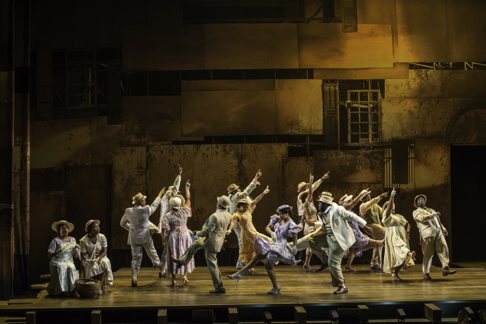 The national cast of THE GERSHWINS' PORGY AND BESS. Photo by Michael J. Lutch
The national cast of THE GERSHWINS' PORGY AND BESS. Photo by Michael J. Lutch
What makes this production of Porgy and Bess become a fine piece of theatrical art is the minimalism of its staging — only a raked stage platform, an abstract ramshackle back wall, a sky scrim for the picnic, a border to make an interior, a hanging lamp to swing in the storm. There are but twenty-two total inhabitants of Catfish Row, and two policemen. These minimal physical and human resources focused our responses onto the opera’s human tragedies through the joys and sorrows we could clearly perceive on each and every face and body on the stage.
The choreography, by Ronald K. Brown too was minimal, just enough to make it a “show” with a few snappy moves by the bodies that could, and even some surprising, acrobatic moves (the four fishermen being fish) by bodies you were sure could not — there were no skinny chorus boys and girls here.
Unlike the broader and deeper exploration of the human spirit that may occur on the opera stage the Broadway musical heads for always direct emotions. Suzan-Lori Parks has Bess deeply in love with Porgy. Clara hands her baby to Bess who becomes its surrogate mother. A dose of happy dust in a weak moment forces Mariah, the matriarch of Catfish Row to expel Bess, who, devastated, has no where to go but New York. Porgy then seems to be going somewhere too, transfixed by love.
It all works and it is all opera, meaning big stories, big emotions, big music, because of the splendid performances of Alicia Hall Moran as Bess, Nathaniel Stampley as Porgy and Alvin Crawford as Crown. Mlle. Moran plays a weak and strong Bess, warm and fun, above all honest. Bess is complex and of course since it is a musical she is very appealing. Mr. Stampley makes Porgy a simple, warm and open spirit, charismatic and quite handsome. Mr. Crawford is a towering, muscular force, dumb and selfish though he too is good underneath it all. All ably vocally negotiated their numbers, especially Mlle. Moran in an appropriately husky mezzo.
Opera audiences will surely savor the pleasures of this smart production, tightly conceived and very well directed. One can wish for such stagecraft on opera house stages where production values on the level of this Porgy and Bess are very rare, too rare indeed.
For comparison with an opera house production please see Porgy and Bess at San Francisco Opera.
Michael Milenski
Casts and production information:
Porgy: Nathaniel Stampley; Bess: Alicia Hall Moran; Clara: Sumayya Ali; Jake: David Hughey; Mariah: Danielle Lee Greaves; Sporting Life: Kingsley Leggs; Mingo: Kent Overshown; Serena: Denisha Ballew; Robbins: James Earl Jones II; Crown: Alvin Crawford; Detective: Dan Barnhill; Policeman: Fred Rose; Strawberry Woman: Sarita Rachelle Lilly; Honey Man; Chauncey Packer; Crab Man; Dwelvan David. Conductor: Dale Rieling. American Repertory Theater production. Book adaptation: Suzan-Lori Parks; Musical score adaptation: Diedre L. Murray; Stage Director: Diane Paulus; Choreography: Ronald K. Brown; Set Design: Riccardo Hernandez; Costume Design: ESosa; Lighting Design: Christopher Akerlind. Golden Gate Theater, San Francisco. November 20, 2013.
image=http://www.operatoday.com/Porgy_SHNSF3.png
image_description=Porgy and Bess in the National Company of "The Gershwins' Porgy and Bess [Photo by Michael J. Lutch]
product=yes
product_title=Porgy and Bess in San Francisco
product_by=A review by Michael Milenski
product_id=Above: Alicia Hall Moran as Bess, Nathaniel Stampley as Porgy in the National Company of "The Gershwins' Porgy and Bess" [Photo by Michael J. Lutch]
November 19, 2013
Arizona Opera Presents a Fine Flying Dutchman
On November 15, 2013, Arizona Opera celebrated Richard Wagner’s two hundredth birthday with a new production of his first success, The Flying Dutchman (Der Fliegende Holländer). Wagner was inspired to write this opera after he fled from Riga where his creditors were hot on his trail. While conducting at the court theater there, he and his first wife, Minna, had run up huge debts. When he lost the job, there was no way he could pay. The court confiscated their passports but they escaped the debt collectors by illegally crossing the border into Prussia. There they boarded a ship for an eight-day passage to London. They encountered terrible storms and high winds which forced their sailing ship to endure a three-week rollercoaster ride as its captain sought shelter along the coast of Norway. The stormy seas made the composer think of Nordic legends, one of which was the story of the Dutchman who could only return to land once in seven years.
Later he wrote: "The voyage through the Norwegian reefs made a wonderful impression on my imagination; the legend of The Flying Dutchman, which the sailors verified, took on a distinctive, strange coloring that only my sea adventures could have given it.” Several of Wagner’s protagonists were men who lived outside of society. Not only does the Dutchman materialize out of the ether, so does Lohengrin. The Dutchman is a wanderer and so are Siegmund, Tannhäuser, and Wotan. The Flying Dutchman was a seminal opera for him.
This opera requires a large orchestra that would not fit in the Phoenix Symphony Hall pit. Since Arizona Opera wanted to use the full complement of musicians, the players were at the back of the stage and the action was mounted on flooring built over the orchestra pit. It brought the singers much closer to the audience and all the overtones and colors in their voices were easily heard. Director Bernard Uzan gave us a realistic interpretation of the story while Peter Dean Beck’s platforms and props made it come to life with the help of this most capable cast. Most of the scenery consisted of Douglas Provost’s visually piquant projections, which included nautical images by Gustave Doré, one of Wagner’s favorite artists. The projection seen upon entry contained portraits of Wagner and Doré.
With the stage in this arrangement, there could be no curtain, so after the overture, Daland, Raymond Aceto, strode onstage from the wings to ask the Steersman to take the next watch. Aceto has a magnificent bass sound and it was all the more evident with him in front of the orchestra. For the Steersman, Christian Reinert, it was not a good thing. He had trouble reaching his high notes and there was no orchestral cover to hide any of it.
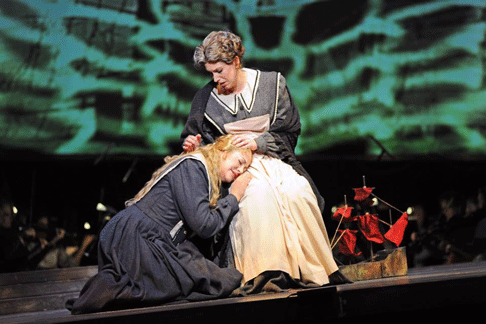
Baritone Mark Delavan was a passionate Dutchman whose cavernous voice surged out over the audience with tonal opulence. A powerful Senta, Lori Phillips’ bright sound energized the text and made her rendition exciting. She is just beginning to emerge as a true dramatic soprano but she is already singing with a distinctively colored sound. It has been many years since a soprano brought as much exhilaration to this role as Phillips did on Saturday night.
Corey Bix was a credible Eric who would have made Senta a good husband had she not been infatuated with the Dutchman and his legend. Young artist program member, Beth Lytwynec showed her ability as a character actress with her portrayal of Senta's work supervisor, Mary, as an old woman. Her singing showed her sonorous, youthful voice, however. Henri Venanzi’s chorus was relegated to a slightly raised area behind the orchestra so they could not move about freely. Although they did perform some dance movements, they made their part clear with robust singing. Conductor Joseph Resigno's lyrical interpretation of this early Wagner score brought out its relationship to the nineteenth century operas that preceded it. His players responded with an exciting rendition that helped make this one of the best performances heard recently at Arizona Opera.
Maria Nockin
Cast and production information:
The Dutchman, Mark Delavan; Daland, Ramond Aceto; Senta, Lori Phillips; Erik, Corey BIx; Steersman, Christian Reinert; Mary, Beth Lytwynec; Director, Bernard Uzan; Conductor, Joseph Resigno; Chorus Master, Henri Venanzi; Lighting and Projection Design, Douglas Provost; Scenery and Props, Peter Dean Beck.
image=http://www.operatoday.com/1465328_551487128254068_170.gif
image_description=Flying Dutchman [Photo by Tim Trumble Photo]
product=yes
product_title=Arizona Opera Presents a Fine Flying Dutchman
product_by=A review by Maria Nockin
product_id=Photos by Tim Trumble Photo
November 18, 2013
The Rape of Lucretia, Glyndebourne Touring Opera
Fiona Shaw’s new production of Britten’s problematic second opera, The Rape of Lucretia, doesn’t quite succeed in answering St Augustine’s question, but it does powerfully communicate the work’s troubling dramatic power and relevance.
This Britten centenary year has brought forth a chest of treasures, familiar and rare. Amid the countless offerings, at home and abroad, of the operatic favourites - from Peter Grimes to Death in Venice - we have enjoyed several renditions of the Canticles and Church Parables, performances of Paul Bunyan and Owen Wingrave, and innumerable masterpieces of the chamber repertoire: ranging from the abstractions of Our Hunting Fathers to balletic presentations of Phaedra, with scarcely a song or chamber work neglected, including Britten’s juvenilia.
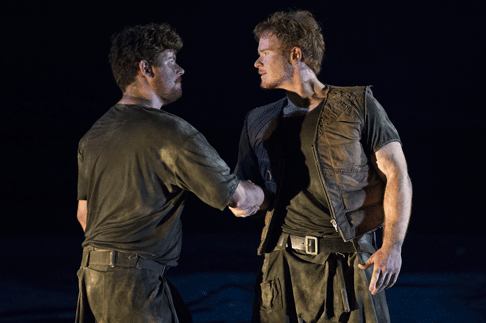
But, Lucretia is a tricky one. Even the television opera, Owen Wingrave - which can sit uncomfortably in a theatrical context and presents characters with whom it is hard to empathise - communicates its ‘meaning’ more directly: whether we consider it a ghost story, anti-war manifesto or psycho-sexual drama, Wingrave is obviously ‘about’ something. But, Lucretia’s ‘message’ is equivocal and elusive; and, this is not wholly the fault of Ronald Duncan’s dreadfully verbose libretto - how, for example, is a composer supposed to respond to lines such as ‘and always he’d pay his way/ With the prodigious liberality/ Of self-coined obsequious flattery’?
Part of the problem lies in the tale itself. In the Roman account, there are no ambiguities: Lucretia kills herself for socio-political reasons - her husband’s power, social status and honour depend upon her virtue. In Shakespeare’s poetic narrative, Lucrece exhibits a guilt which is laden with Christian misogyny: she is beautiful, and her loveliness and purity has provoked Tarquin’s natural, masculine sexuality - so it’s her fault, like Eve, and the least she can do for the sake of everyone else is finish things off quickly.
Britten’s opera shifts between the two positions. We begin in a Roman military camp beside the Tiber, the formal device of the Male and Female chorus distancing us from the action in the manner of Greek tragedy. Indulging in crude banter, the boisterous soldiers praise Lucretia’s steadfastness and goodness, and the Male Chorus acknowledges, ‘Collatinus is politically astute to choose a virtuous wife./ Collatinus shines bright from Lucretia’s fame’.
However, contradicting this ‘historical’ focus, in their first lines the Choruses announce, ‘We’ll view these human passions and these years/ Through eyes which once have wept with Christ’s own tears’, establishing a specifically Christian perspective, one confirmed in Lucretia’s dying words, ‘See, how my wanton blood/ Washes my shame away!’ And, then there is the Christian epilogue which offers salvation to the participants’ despairing cry, ‘Is this all?’: ‘Jesus Christ. He is all! He is all!’ It’s all rather confusing.
Fiona Shaw and her design team (sets Michael Levine, lighting Paul Anderson, costume Nicky Gillibrand) opt for desolation with scarce hint of salvation. A bleak, raked stage, covered with earth overlain with a grubby black cloth, is dimly lit. Throughout the opera, the characters struggle to climb this incline, a physical manifestation of their worldly troubles and inner torments, and turn from us to peer into the delicate blue light which glows from afar - an elusive emblem of hope perhaps, but ever unattainable.
The cloth is raised with a single, central pole to form a dingy encampment. Drunken soldiers squat in the dark corners of the crowded tent, their fatigues reminding us that war, with its suffering and atrocities, is not merely an historical phenomenon. The Male and Female Choruses, dressed in dull 1940s clothing, are our conduit, via WWII, to this former era. In the libretto, the house curtain rises to show the Chorus ‘reading from books’; but Shaw literally digs her way back into antiquity, the Male Chorus scrabbling in a muddy pit from which Lucretia is later unearthed. Similarly, Collatinus’s house is an archaeological site, its perimeter marked by excavators’ tape, only a few foundation stones and rubble indicating its inner dimensions.
The gloom is ubiquitous, a cross-shaped standard lap providing weak illumination. Only at the start of Act 2, when Lucretia lies asleep, dreaming ‘the sunken treasures of heavy sleep’, does Anderson shine a gleaming white spotlight on her resting form, the sudden contrast powerfully evoking the purity of one who is ‘as light as a lily that floats upon a lake’. However, the glistening transparency proves poignantly fragile and defenceless against Tarquinius’ lust - ‘Loveliness like this is never chaste; If not enjoyed, it is just waste!’ Shaw shows us, explicitly and indisputably, how Tarquinius is driven to destroy the very beauty that he desires, Lucretia’s defilement taking place amid the earth and gravel of a dark, Hadean pit. At the end, it is from this pit that severed limbs and a head are unearthed; the Choruses’ closing religious consolations are bitterly unconvincing.
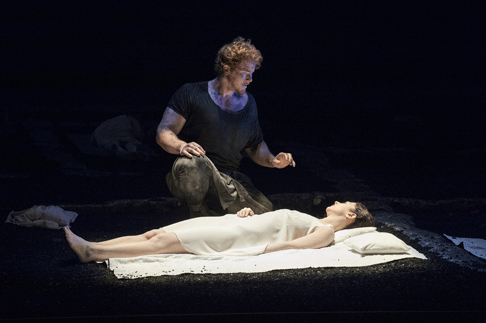
On 15th November, the young cast were on fine form. Andrew Dickinson and Kate Valentine were outstanding as the Male and Female Chorus respectively, engaging our interest and our feelings as they related and participated in the unfolding tragedy. Dickinson articulated Duncan’s literary turgidities with clarity and fluency, his delivery natural and unmannered but the sentiments heartfelt. Valentine sang with generous tone and warmth, always relaxed, blending beautifully with Dickinson in the duet refrain which punctuates the opera. The lullaby which the Female Chorus sings over Lucretia’s sleeping form was elegant and touching, enhanced by some exquisite playing by alto flute, bass clarinet and horn.
Britten and Duncan originally conceived the Choruses as commentators, relating a tale from the annals of Roman history (as the curtain falls on Act 1, they ‘pick up their books and continue reading’). At times, Shaw’s Choruses adopted a similarly distanced viewpoint but elsewhere they travelled back through time, and engaged and interacted with the past. So, as Dickinson related the account of Tarquinius’s nocturnal journey to Rome, his precipitous flight was mimed in the background while the Female Chorus tried to intercept and deter the dissolute Roman ruler as he recklessly lamed his horse and plunged into the Tiber, propelled by jealousy and lust. Such interaction added immediacy and deepened our empathy. The occurrences of the distant past have been undergone by many since: during WWII and in the present day. Shaw shows us that the story the Choruses tell, is their tale too; but, it does seem a step too far to suggest an intimate sexual attraction between the two Choruses …
The role of Lucretia was originally written for Kathleen Ferrier; Claudia Huckle may not possess a voice of such ample fullness, but after a slightly hesitant start she produced an intense and affecting performance. She acted with intelligence and commitment. A voice that initially embodied lightness and composure, transmuted after her violation to darker tones conveying vulnerability and self-castigation. Her confession was rich, mobile and expressive, her exposure unveiling a troubling guilt as Tarquinius’s desire became her crime. Huckle’s Lucretia is no artificial idol; rather she is a real, flesh-and-blood woman, shocked and destroyed by her own unbidden passions.
Duncan’s libretto depicts the rigid divisions in Roman society between male and female groups. Here, the Etruscan soldiers were crude, misogynistic competitors, convincingly brazen and coarse. In contrast, Ellie Laugharne’s lively, bright Lucia and Catherine Wyn-Rogers pure-toned Bianca suggested honest, uncomplicated friendship and love within the female domain.
Oliver Dunn revealed an appealing baritone and sure dramatic instincts as Junius. David Soar presented a well-rounded Collatinus, his strident Act 1 soliloquy on ‘love’ giving way to tender and profound sincerity following Lucretia’s confession, supported by rising woodwind and harp accompaniment gently intimating hope; ironically his forgiveness merely exacerbated Lucretia’s remorse.
As Tarquinius, Duncan Rock was fittingly assertive and muscular, although his aggression and brashness was modulated by moments of lyricism. Enraged by taunts and boasts, stirred by Lucretia’s beauty and virtue, his passionate outburst before his assault was poetic and ecstatic.
After the rape, Rock sadly conveyed a sense of his own loss - ‘Though I have won/ I’m lost./ Give me my soul/ Again/ In your veins sleep/ My rest.’; his Tarquinius was to be both censured and pitied.
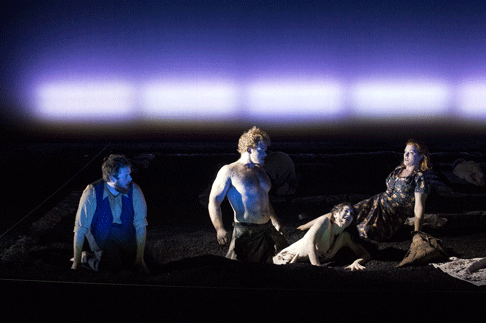
Britten’s score is sparse, fitting for the post-war cultural climate when the work was composed, and ideal for our own ‘age of austerity’. In contrast to the drab bleakness on stage, the twelve instrumentalists conducted by Jack Ridley responded wonderfully to the transparent lucidities of Britten’s scoring. As Tarquinius crept through Lucretia’s house, the percussion’s nervous motifs skilfully depicted the explosive tension within the assailant. There was some enchantingly sensitive playing from harpist Sue Blair, and Alan Darbyshire’s silky cor anglais melody, above unsettling off-beat bass quavers, deepened the poignancy of Lucretia’s entrance preceding her confession.
In an article, ‘The Problems of a Librettist: Is Opera Emotionally Immature?’, Duncan suggested that the opera continued the dramatization of the conflict between the individual and society begun in Peter Grimes: ‘the individual is personified by Lucretia whose virtuous personality is persecuted, raped, by Tarquinius, who symbolises Society’. A more abstract reading might propose that the opera explores relationships between desire and violence, love and sin: after Lucretia’s death, the whole cast cry: ‘How is it possible that she/ Being so pure should die!’
But, for all the digging and delving, Fiona Shaw doesn’t find historical or philosophical ‘truth’: Lucretia’s suicide is presented more as a personal purgation than a social sacrifice, but the intimations of her guilt are neither confirmed nor eradicated. The Christian epilogue does not provide a redemptive framework: we do not equate Lucretia’s suffering with Christ’s crucifixion. But, this doesn’t matter. Shaw offers an intensely moving spectacle. As Lucretia herself says: ‘What I have spoken never can be forgotten.’
Claire Seymour
Glyndebourne Touring Opera will perform in Milton Keynes 19-23 November, Plymouth 24-30 November and Stoke-on-Trent 11/14 December.
Listen to the Rape of Lucretia podcast
Cast and production information:
Male Chorus, Andrew Dickinson; Female Chorus, Kate Valentine; Collatinus, David Soar; Junius, Oliver Dunn; Tarquinius, Duncan Rock; Lucretia, Claudia Huckle; Bianca, Catherine Wyn-Rogers; Lucia Ellie Laugharne; Director, Fiona Shaw; Conductor, Jack Ridley; Set Designer, Michael Levine; Lighting Designer, Paul Anderson; Costume Designer, Nicky Gillibrand; The Glyndebourne Tour Orchestra. Glyndebourne Touring Opera. The Marlowe Theatre, Canterbury, Friday 15th November, 2013.
image=http://www.operatoday.com/RapeofLucretia_2501.gif image_description =Scene from The Rape of Lucretia [Photo by Richard Hubert Smith courtesy of Glyndebourne Touring Opera] product=yes product_title=The Rape of Lucretia, Glyndebourne Touring Opera product_by=A review by Claire Seymour product_id=Above: Scene from The Rape of LucretiaPhotos by Richard Hubert Smith courtesy of Glyndebourne Touring Opera
November 17, 2013
The Barber of Seville in San Francisco
It is the staging of Spanish stage director Emilio Sagi (pronounced saw-he) that has many of the ideas he first explored at Madrid’s Teatro Real in a big production that then traveled to Los Angeles, both cities likely harbors for its witty and affectionate quoting of classic hispanic flamenco postures. This San Francisco Barber is a slimmed down, re-elaborated version of the original Sagi conception that will soon be shared with the Lithuanian National Opera.
There was much to like on opening night, notably the polished performances of Count Almaviva and his future countess, characters also known as Lindoro sung by Mexican tenor Janvier Camarena and Rosina sung by American mezzo-soprano Isabel Leonard.
Mr. Camarena provided the high points of the evening, accompanying himself on the guitar for the serenade with virtuoso plucking technique, acting the music teacher with the skill of a sure comedian. To top it off he gave us the rare “Cessa di più risistere” later known and now better known as “Non piu mesta” from La cenerentola in a dazzling display of fioratura and high notes that brought the house down.
Mlle. Leonard, if not of pure hispanic origin (her mother was Argentine) even so matched Mr. Camarena’s latin excitement and brilliant singing with a presence that exuded refined fun and projected mature vocal and histrionic confidence — a poised Rosina who knew what she wanted and how to get it. Once a student at the Joffrey Ballet School she was well prepared to snap out flamenco poses that easily outclassed those of the official ballerinas.
There were moments of fine, idiomatic conducting. Italian conductor Giuseppe Finzi effectively captured the ephemeral Rossini ethos from time to time (the joy and blatant fun of singing difficult, florid music with aplomb), particularly in his support of the arias of these two singers. As well the maestro often caught the transparent rhythms of the big ensembles where three to six complex and sometimes more vocal lines compete with complete musical ease, conviction and wit.
The set, designed by Spaniard Llorenç Corbella, is quite different from the Madrid production. Here it is essentially a narrow, diagonally raked platform thrusting upstage, with an adjacent abstract black area (no scenery) accessible to various contraptions on wheels and lots of choristers. At best the set worked well, the rake providing a dynamic line on which the principals moved up and down, on and off, the black area serving as a space to stage business that elaborates the various musical numbers.
Besides the witty gloss of the flamenco poses, the Sagi production was embellished with lots of spoke wheel vehicles (bicycle like) that gave a sense of lightness and fleetness to the staging that flouted period (century or decade). The costumes as well were embellished with witty abstractions of Sevillian decorations that had little to do with period and everything to do taking costumes onto an abstract musical level.
Various human bodies and objects crawled out from under the raked platform and props flew down from above from time to time to further negate any sense of real time or real space. Barber’s various numbers were arbitrarily placed on the ramp or in the black space and finally everything more or less disappeared anyway to reveal a night sky filled with fireworks (projected). In short director Sagi and his designer Corbella concocted a heady framework for the music of Rossini’s masterpiece. It would have been truly brilliant had it gotten off the ground.
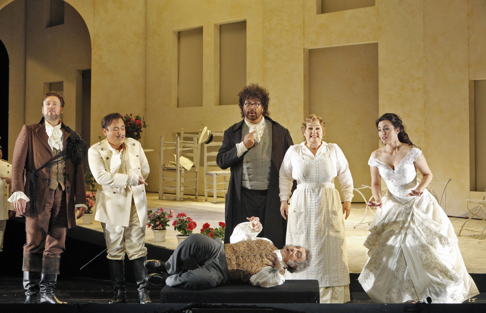 Lucas Meachem as Figaro, Janvier Camarena as Almaviva, Alessandro Corbelli as Bartolo, Andrea Silvestrelli as Basilio, Catherine Cook as Berta, Isabel Leonard as Rosina [Photo by Cory Weaver]
Lucas Meachem as Figaro, Janvier Camarena as Almaviva, Alessandro Corbelli as Bartolo, Andrea Silvestrelli as Basilio, Catherine Cook as Berta, Isabel Leonard as Rosina [Photo by Cory Weaver]
Unfortunately stage director Sagi was more interested in exploring these interesting theatrical ideas than in staging his singers. This lack of a unified and focused dramatic intelligence resulted in the feeling that Rossini’s headstrong characters were arbitrarily walking through the classic comedic process rather than bringing it to life.
A plodding succession of the events of the story we know so well resulted. This sense was exacerbated in the pit. While conductor Finzi did have his truly splendid moments, and there many of them he could not impose a larger musical unity over an act or the evening, evidenced by the overture that ignited no excitement whatsoever. There was a sense of relief when nine dancers appeared to maybe add some life with a bit of abstracted flamenco movement. Alas the choreography was clumsy and meaningless, later met with feelings of dread whenever the dancing became lengthy.
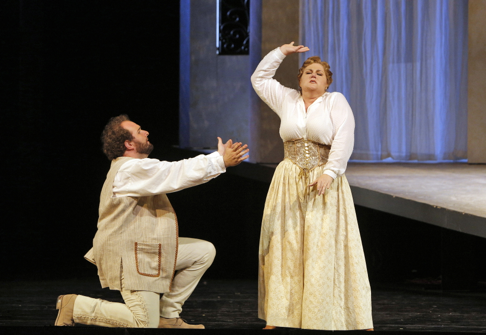 A.J. Glueckert as Ambrogio, Catherine Cook as Berta [Photo by Cory Weaver]
A.J. Glueckert as Ambrogio, Catherine Cook as Berta [Photo by Cory Weaver]
Catherine Cook was the Berta who was as lightheaded as Rosina was weighty minded. She made her aria another of the evening’s high points with the help of her adoring Ambrogio, Adler Fellow A.J. Glueckert who shined as a silent, physical performance artist given he has hardly anything to sing. Bass baritone Hadleigh Adams brought snap and flair to the brief role of the Officer, not allowing his few moments on stage to go unnoticed.
Andrea Silvestrelli brought the considerable panache he provides Rigoletto’s Sparafucile to the role of Basilio. This major role stood out as miscast, and as a vocal misfit into Rossini’s vocal and musical textures. Much the same can be said of the Figaro of Lucas Meachem who confused bellowing with singing and strutting with acting. Italian bass baritone Alessandro Corbelli is a small scale if accomplished Bartolo who here disappeared into the melée rather than making himself the cause of it all.
Of the many, many Barbiere productions encountered over the years, this one stacks up among the best. Its glaring flaws could have easily been overcome with more careful casting, conducting, lighting and directing.
Michael Milenski
Cast and production information:
Figaro: Lucas Meachem; Rosina: Isabel Leonard; Count Almaviva: Javier Camarena; Doctor Bartolo: Alessandro Corbelli; Don Basilio: Andrea Silvestrelli; Berta: Catherine Cook; Ambrogio: A.J. Glueckert; Fiorello: Ao Li; An Officer: Hadleigh Adams; Notary: Andrew Truett. San Francisco Opera Chorus and Orchestra. Conductor: Giuseppe Finzi. Stage director: Emilio Sagi; Set Designer: Llorenc Corbella; Costume Designer: Pepa Ojanguren; Lighting Designer: Gary Marder; Choreographer: Nuria Castejón. San Francisco War Memorial Opera House. November 13, 2013.
image=http://www.operatoday.com/BarberSF_Top.png
image_description=Rosina and Lindoro in Il barbiere di Siviglia [Photo by Cory Weaver]
product=yes
product_title=The Barber of Seville in San Francisco
product_by=A review by Michael Milenski
product_id=Above: Rosina and Lindoro in Il barbiere di Siviglia [Photos by Cory Weaver, courtesy of San Francisco Opera]
November 11, 2013
Britten’s Atmospheric War Requiem, London
The sense of occasion was overwhelming.
The vast auditorium was packed, and the arena area where Prommers throng in summer, was filled with seats. Before the performance began, the house lights were turned, not onto the stage but onto the audience. It was a moment of sheer theatre, but utterly appropriate, for everyone in the building must have known, or know of someone affected by the barbarity of war. No-one could remain unmoved. Wilfred Owen wrote about the First World War, and Britten wrote to commemorate peace after the Second World War. But the world is still wracked by conflict. Wars of attrition continue, millions of people still suffer. Turning the spotlight on the audience reminded us that Remembrance is more than "Lest we forget" but also implies moral obligation.
How amazing it must have been for the performers to look onto the Royal Albert Hall and see the lights shining on thousands of faces! This was infinitely more a communal experience than just a musical event. The lines between performance and reception blurred. Normal measure of performance were largely irrelevant. We were all participating in something much greater than ourselves.
Because the War Requiem was commissioned to mark the rebuilding of Coventry Cathedral, it has become associated with vast venues and ostentatious displays of public piety. Although it's written for some 300 performers, at the really critical moments, Britten silences the tumult. Britten was essentially a private man, not given to big public gestures of emotion. The heart of the piece is the twelve member ensemble that accompanies the two male soloists. The choruses and the female soloist sing in Latin, and sing words that would fit neatly into any standard Requiem Mass. Significantly, Britten sets the key texts in English, using the words of Wilfred Owen, who wrote from personal experience. Owen does not celebrate public victory : quite the opposite. He fought bravely, but eschewed formal religion. Britten doesn't quote the biblical story of Abraham and Isaac, but Wifred Owen's Parable of the Old Men and the Young, with its reference to the wilful slaying, not sanctioned by God, of "half the seed of Europe, one by one"
"Move him into the sun" sings the tenor (Allan Clayton). The quote is from a poem titled Futility. A corpse lies on snowbound ground. The soprano and choruses sing "Lachrymosa", of tears and the conventional expression of sorrow. The music is beautiful, but Owen, and Britten are having none of this. "O what made fatuous sunbeams toil, to break earth's sleep at all"? Unlike seeds in the soil, the dead don't re-sprout. In the Sanctus, the choirs sing "Hosanna in excelcis". But Britten has the baritone (Roderick Williams) sing, quite pointedly "Mine ancient scars should not be gloried. Nor my titanic tears, the seas, be dried". Britten's War Requiem isn't designed to comfort, as much as to provoke.
Bychkov places the chamber ensemble to his immediate left, "the heart side" in theatre parlance.The instrumentation mimics that of a large orchestra - five strings, four winds, horn, harp and percussion - but the individual voices are heard clearly : It's another indication of Britten's "inner" programme.
"Lbera me, Domine" the soprano (Sabina Cvilak) sings, haloed by the chorus. "Tremens factus sum ego" (I tremble and fear) The orchestra screams, cymbals crashing, suggesting the chaos of battle. Bychkov's definition of horns, trumpets and trombones was specially good, emphasizing military conflict. But Britten deliberately shifts focus. To minimal accompaniment the tenor sings ""Strange friend, I said, here is no cause to mourn". Tenor and baritone face each other in a strange No Man's Land where nations do not fight. There are no "Germans" or "British" here but two human beings, man to man. Their voices blend. "Let us sleep now", singing in unity. They are turning away from the vast forces around them. Perhaps Britten recognized that social forces dominate over the private. The War Requiem ends on a wave of uplifting glory, sending the audience out into the world feeling the better for having been part of the experience.
Anne Ozorio
image=http://www.operatoday.com/WWI.png
image_description=A World War I battle scene [Source: US Army]
product=yes
product_title=Britten’s Atmospheric War Requiem, London
product_by=A review by Anne Ozorio
product_id=Above: A World War I battle scene [Source: US Army]
November 9, 2013
Barbican Britten
However, Robert Tear, John Vickers, Philip Langridge and others established themselves as worthy and independent heirs, forging interpretations which were original, insightful and distinctive. Today we are fortunate to have a stellar crop of tenors who bring unique and fresh insights to Britten’s music, but it is a rare combination of cerebral insight and visceral but controlled passion which characterises Ian Bostridge’s responses and which makes his performances so captivating.
Written for the 1936 Norwich Festival, Britten’s orchestral song cycle Our Hunting Fathers certainly demands of its soloist both intellectual perspicacity and emotional immersion, two erudite, philosophical poems by W.H. Auden — Britten’s perennial collaborator during the 1930s — framing three energised Anglo-Saxon texts, the latter modernised by Auden. As Britten anticipated, the first performance, by the LPO and soloist Sophie Wyss, was not well-received: superficially the poetry examines man’s relationship with the animal kingdom, but there exists a both a political dimension and a less obvious sexual sub-text which the local audience were slow to perceive or appreciate, Auden’s complex imagery and verbal dexterity proving overly recondite.
This performance by Ian Bostridge, accompanied by the Britten Sinfonia conducted by Paul Daniel, brought clarity and focus to the superficially obscure poetry, brilliantly conveying the musical structure which unites the diversity of styles required to communicate the varied sentiments of the texts.
In the opening recitative of the ‘Prologue’, marked sempre ad lib., Bostridge’s tone was restrained, perfectly emulating the parsonical mood of the words; the dry orchestral accompaniment facilitated the supremacy of the vocal line. Daniel encouraged the woodwind — who played superbly throughout the evening — in their interjections which contrast with the sustained string chords, casting light on significant lines of text: ‘the poles between which our desire unceasingly is discharged.’ At the image of the ‘extraordinary compulsion of the deluge and earthquake’, Bostridge’s rising minor ninths were deeply poignant, the sustained ppp string chord with trilling side drum and snares surging to an explosive fff.
‘Rats Away!’ is an anonymous medieval text which depicts animals as vermin, the primarily wind-based orchestration and scurrying musical material presenting an unsentimental, hard-edged world.
Bostridge’s virtuosic dexterity was evident in his florid melismatic variant of the opening orchestral gestures; he projected the scalic figure, ‘Rats!’, with clarity and precision combined with cadenza-like energy — aspiring with propulsive vigour towards the climactic, sustained high A — while Daniel drew forth a shrill timbre from the tremolando strings and flutter-tonguing woodwind. A contrasting mood was established in the central section, the voice articulating a sort of invocatory prayer in discourse with a legato solo viola (Clare Finnimore); here, Bostridge shaped the passage with consummate control, incisively accenting the leaping octaves which announce the names of the Evangelists and driving towards the intervallic expansiveness of the climactic phrase, ‘That these names were utter’d in’. The insistent repetitions of the three-note ‘Rats!’ motif in the recapitulation were terrifyingly dynamic, and the tenor’s final throw-away ‘Amen’, dropping from high decorative exclamations to a low D, after a laden pause, sardonically emphasised the satirical nature of the religious statements in the text — a cynicism which was further confirmed by the motivic continuations of the unison strings, which Daniel guided into ambiguous dissolution.
In ‘Messalina’ we move from public to private domains, as the singer mourns the loss of his pet monkey. Bostridge’s drooping lament, ‘Ay, ay me, alas, heigh ho!’, richly resonated with the hollowness of the divided strings’ opening 5ths, the singer’s glissandi falling 7ths both musically precise and ardently expressive. The narrative lines, ‘Thus doth Messalina go/ Up and down the house a-cry’, possessed a folk-like naivety, as the solo woodwind melodies intertwined with the voice. The elaborate, melismatic cries of ‘Fie!’ were electrifying: Bostridge was not afraid to push his voice to the limits through the tumbling major/minor thirds, the quiet registral expanse of soaring molto espressivo e vibrato strings above deep tuba and trombone expressed both the wide scope of emotions experienced and the chasm of grief. The tenor’s stabbing crotchets, ‘Fie!’, dissipated into despair and some beautiful solos from horn, bassoon and alto saxophone, the latter lyrically played by Christian Forshaw, led us without pause into Britten’s setting of Thomas Ravenscroft’s ‘Dance of Death’ — ‘Hawking for the Partridge’.
The tenor’s initial roll call of predators — ‘Beauty, Timble, Trover, Damsel’ — was savage, the tight tarantella rhythm a parody of the traditional hunting song. Bostridge whistled through his teeth, the repeated rising 9th, ‘Whurrrrret!’, penetrating and discomforting; indeed, the sense of a self-gratifying pleasure in violence is given an ominous twist in the subsequent passage, where the isolation and repetition of the words ‘Travel Jew’ portentously equates the ritual killing of animals with the ‘Jew-hunting’ perpetrated by Nazi Germany — as ever, Bostridge was alert to every nuance and inference of the text, and to the musical opportunities for its expression. Daniel drew forth the multitude of onomatopoeic motifs — the woodwinds’ staccato flurry of feathers, the horn’s rasping glissandi of alarm — creating a mood of terror and hysteria.
The conductor sustained the insistent rhythms of the ‘Dance of Death’ in the concluding ‘Epilogue and Funeral March’; the ostinato xylophone soullessly suggested man’s inability to break out of the endless cycle of cruelty and despair. This movement possesses a disturbing tension and ambiguity, and Bostridge and Daniel made much of the contrasts between Auden’s two stanzas, exploiting Britten’s interjections and imitative sounds.
Auden’s first stanza describes the traditional self-assurance of man, who pities the animals’ undirected innocence and whose own love, the driving power which motivates the individual, is tempered by reason. However, in the second stanza Auden proposes a ‘modern’ view of a love which leads to guilt and self-regard, adapting lines from Lenin to ask us to imagine a man who has modified his ‘southern gestures’ and makes it his ambition only ‘To hunger, work illegally,/ And be anonymous?’
Bostridge’s extended melisma, contrasting powerfully with the composure of the preceding syllabic lines, was finely crafted: initially restrained — recalling the opening of the ‘Prologue’ — then flowering exquisitely into an impassioned arioso. In the concluding funeral march, Daniel fashioned a controlled disintegration, as the bass faded away leaving hard col legno and pizzicato strings to offer the final inconclusive, pessimistic utterances.
Elsewhere in the programme the prodigious talents of the Britten Sinfonia — individually and collectively — were much on display. A pacy reading of Britten’s arrangement of Purcell’s Chacony in G Minor allowed the strings to demonstrate their responsive appreciation of the composer’s rhythmic vitality and impulsiveness, as well as their feeling for colour and dynamic range. Daniel’s flexible, free direction suggested that he is a dancer manqué, so lithe and unconstrained were his gestures.
Young pianist, Lara Melda — the winner of the BBC Young Musician of the Year competition in 2010 — was a dazzling soloist in Britten’s Young Apollo (for piano, string quartet and string orchestra), sparkling through the rising scales in scintillating fashion above gleaming, brilliant strings. Her reading was full of the bright optimism of youth; fittingly, for the work was first performed in Toronto in 1939 with the 25-year-old composer himself at the keyboard.
Tippett’s Fantasia concertante on a theme of Corelli was engagingly theatrical, the textures rich and the elaborate ornamentations lavishly conveyed. Soloists Thomas Gould (violin), Miranda Dale (violin) and Caroline Dearnley (cello) were superb, Gould in particular galvanising all the instrumentalists to offer an uplifting, deeply committed performance.
Britten’s Suite on English Folk Tunes bears the sub-title ‘A Time There Was’ — an allusion to Thomas Hardy’s Winter Words — and the inscription, ‘lovingly and reverently dedicate to the memory of Percy Grainger’. At first glance, it might be felt that Britten and Grainger have little in common, but a penetratingly creative engagement with English folk-song links the two disparate personalities, and in this performance Daniel demonstrated a discerning appreciation of the relationship between the simple, straightforward folk-song melodies and the, at times, disruptive accompaniments. The final movement, a setting of ‘Lord Melbourne’ which was collected by Grainger, was imbued with a draining dejection, redolent of Hardy’s verse.
Claire Seymour
‘Barbican Britten’ continues until 24th November — see www.barbican.org.uk for further details.
Programme and performers:
Henry Purcell, arr. Benjamin Britten, Chacony in G Minor; Benjamin Britten, Young Apollo Op.16; Michael Tippett,Fantasia concertante on a theme of Corelli; Benjamin Britten, Our Hunting Fathers, Op.8; Benjamin Britten, Suite on English Folk Tunes (A Time There Was). Ian Bostridge, tenor; Lara Melda, piano; Paul Daniel, conductor; Britten Sinfonia. Barbican Centre, London, Friday 8th November 2013.
image=http://www.operatoday.com/Britten-Sinfonia.png image_description=Britten Sinfonia product=yes product_title=Barbican Britten product_by=A review by Claire Seymour product_id=Above: Britten SinfoniaNovember 8, 2013
Exaudi: O tenebroso giorno — Gesualdo then and now
Carlo Gesualdo, Prince of Venosa, was the warp between which the weft threads of modernism were woven. Madrigalist, mannerist and master of harmonic ingenuity, the patrician composer’s contributions to the genre are remarkable for their harmonic capriciousness and volatility. Much is often made of the fact that one can add ‘murderer’ to the alliterative inventory of the composer’s roles, his violent despatch of his faithless wife and her lover earning him notoriety in the annals of music history; and, while such vengeful acts were in fact common in Renaissance Italian courts — indeed, the contemporary code of honour practically demanded them — it is perhaps not too fanciful to imagine that something of Gesualdo’s brooding, melancholic temperament is evident in the turbulent harmonic daring of his madrigals.
It has been suggested that Gesualdo’s harmonic adventurousness was inspired by his visits to Ferrara from 1594, where he was able to experiment upon the archicembalo with six keyboards that had been constructed by the court maestro Nicola Vicentino. But, it is just as likely that overhearing the vocal ensemble that Vicentino had trained in secrecy, in order to put into practice his own experimental theories of music, was the major influence in the formation of Gesualdo’s idiosyncratic idiom.
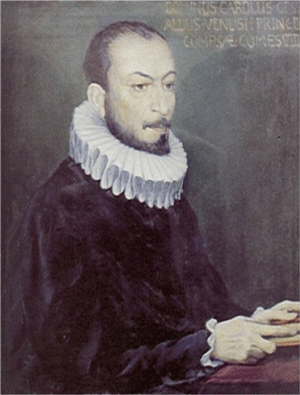 Carlo Gesualdo, Prince of Venosa [Source: Wikipedia]
Carlo Gesualdo, Prince of Venosa [Source: Wikipedia]
Writing of a new edition of the madrigals published in1962, the musicologist Denis Stevens declared, ‘Five fine soloists, each with perfect intonation, not too much vibrato, and a really controlled line, would bring … [the] splendid pieces in this book to life’. ‘Dolcissima mia vita’ (Sweetness life of mine) immediately asserted the composer’s highly personal vein of chromatic irregularity, and five members of Exaudi , although they took a few minutes to settle, certainly brought vitality to the contrapuntal lines, ‘Credete forse che’l bel foco ond’ardo’ (Can you believe the fire that now scorches me), triggered by a buoyant countertenor line sung by Tom Williams.
The sliding chromatic resolutions of ‘Deh, come invan sospiro’ (Ah! How I sigh in vain) demonstrated the composer’s skill in expressing the struggle between violent, conflicting emotions, while the closing repetitions of ‘divenga morte’ (life for me has become death) spanned a spectrum of colours and moods, both rich and shadowy. In ‘Tu piangi, o Filli mia’ (You weep, O my Phyllis), the five voices blended agreeably; in an energetic rendition, the strong communication between the members of the quintet was evident in the vivid sectional contrasts that were achieved.
Gesualdo’s almost hypersensitive response to lyric emotions is unfailingly astonishing, as the individual vocal lines veer in unexpected directions, the linear discourses producing a questing, searching mood as dissonances are suspended and resolutions delayed. In ‘Itene, o miei sospiri’ (Go now, o my sighs) the sheer force of the harmonic energy was remarkable, building from the initial direct command, ‘Itene’, to the rich contrapuntal interweaving of the climax, before the relaxation of the concluding homophonic thirds. The deep register of the opening of ‘O tenebroso giorno’ (O dark day) was forbiddingly sombre, before the more uplifting harmonies of ‘Quando lieto ritorno/ Farai dinanzi a quella/Che è più d’ogni altra bella’ (When will you happily/ return to that beauty’s side/ who is more beautiful than any other) created a flowing lightness. The voices negotiated the unusual, challenging intervals of the melodic lines with pinpoint accuracy, and the final phrase possessed a pure air of expansiveness: ‘Che con suoi sguardi morte e vita appaga?’ (whose gaze satisfies both death and life?’).
The rich open vowel sounds of ‘O dolorosa gioia’ (Oh dolorous joy), sung with lustrous timbre, opened the second half of the recital; the five vocalists enjoyed the harmonic paradoxes used to convey the oxymoronic verse — unexpectedly easeful major harmonies suggest ‘soave dolore’ (sweet suffering), for example. The final line, ‘Poichè sì docle mi fa morto e vivo’ (for so sweetly it makes me feel both dead and alive) had both immediacy and aloofness. The fitful changes of mood of the brief ‘Moro, lasso’ (I die, alas), were powerfully communicated, the despairing cry, ‘Ahi, che m’ancide e non vuo!’ (oh, kills me and will not help me!), full of rhetorical directness.
Two madrigals à 6 brought the sequence to a close: ‘Tenebrae factae sunt’ (Darkness covered the earth) had both solemn depth and warmth, while the incessant suspensions and twists of ‘Caligaverunt oculi mei’ (My eyes are dimmed), particularly in the final homophonic section, were meticulously precise and moving.
Interspersed between the Renaissance treasures were four contemporary works; the present in conversation with the past. (The Gesualdo works were performed without conductor, while director James Weeks led the new madrigals). Stefano Gervanosi’s ‘Amore l’alma m’allaccia’ (Tasso, Love tightens my soul), for SSATB, was immensely challenging with its dense, iridescent sonorities and textures, the accumulating harmonic tension provocatively evoking the pain of ‘dolci aspre catene’ (sweet bitter chains). Repetition of miniature motifs built to an imitative frenzy, and the singers demonstrated rhythmic precision and expert ensemble in the more airy, fragmented closing section, the brief vocal snatches intimating the erotic tensions of the text.
Exaudi performed Michael Finnissy’s Sesto Libro di Carlo Gesualdo I in October 2012; at that time, I remarked the way the composer ‘exploited the sinuous false relations, suspensions and dissonances of the sixteenth-century idiom … explicitly intertwining elements of Gesualdo’s original with Finnissy’s own elaborations and developments’. Here, three later songs from the set were presented. The transparent texture of the 2-voice opening to III, ‘Beltà poi che t’assenti’ (My beauty, since you are gone) was enriched by piquant close dissonances, while the sustained lamenting lines of the end were affectingly shaped. IV, ‘Quel ‘no’ crudel che la mia speme ancise’ (That cruel ‘no’ which killed my hope), presented copious challenges for the two sopranos and for conductor, Weeks, whose broad loops emphatically marked the points of coincidence amid the free rhapsodic sweeps of the vocal lines, with their eerie glissandi and ululations. As the voices moved apart in register, the interplay between the burnished lower voice and the soaring high soprano effectively conveyed love’s power to ‘vince ogni core’ (conquer all hearts). A denser texture characterised VI, ‘Resta di darmi noia’ (Cease to give me annoyance), the five voices vividly articulating the opening text in homophonous broken rhythms; above a bed of sustained chords, tenor and soprano engaged in a veritable vocal battle of passion and bitterness: ‘Morta è per me la gioia,/ Onde sperar non lice/ D’esser mai più felice’ (For me all joy is dead, nor can I ever hope again to find happiness).
Christopher Fox’s ‘suo tormento’ (His torment) is a setting of an extract from Dante’s ‘Inferno’ Canto X, although as the composer’s programme note explained: ‘Dante’s text … is used only as a sound-source and in the score the source-word for each sound is given [in square brackets] to indicate how the underlaid letters should sound. The text is ‘read’ outwards from the centre … reading, as it were, into both past and future — and the music should sound like a doomed attempt to be understood.’ Certainly, the broken phrases expressed a sense of frustrated attempts to see and comprehend and a vexing impotence. Two shorts settings of Antonio Gramsci followed, the words set in more conventional fashion. ‘figura’, ‘hoketus’ and ‘kanon’ from Johannes Schöllhorn’s Madrigali a Dio (texts by Pier Paolo Pasolini) was the last of the modern offerings. Set for 6 voices these madrigals are cerebral works, ‘figura’ opening with a wave-like drone, with the voices freely and linearly interacting with each other in complex just intonation. ‘hoketus’ was energised and unpredictable, meaning conveyed by sound rather than sense, whirling glissandi and introverted ‘chattering’ representing ‘una sola/ Parola, una sola/ Parola ripete pazzamente’ (a single word, a single word madly repeats). The stratospheric soprano in ‘kanon’ was effortlessly delivered by Juliet Fraser, above an energetic counterpoint of male voices. Needless to say, these works demanded enormous precision of rhythm and pitch, perfect ensemble as well as vocal confidence; the members of Exaudi exhibited all these qualities in abundance.
I’ve previously expressed reservations, and I’m still not convinced, that director James Weeks’ inter-madrigal commentaries, though direct and engaging, are truly necessary or beneficial: for they weaken the continuity of the musical dialogue between past and present, a musical conversation which would be stronger if fluid and uninterrupted by the spoken word. But, in the final reckoning the music spoke for itself: the noble humanistic spirit of the Renaissance madrigal, underpinned by the potency of intense vocal expression, is alive and well.
Claire Seymour
Cast and production information:
James Weeks, director; Juliet Fraser, Amanda Morrison, soprano; Lucy Goddard, mezzo-soprano; Tom Williams, countertenor; Stephen Jeffes, Jonathan Bungard, tenor; Jonathan Saunders, Simon Whiteley, bass. Wigmore Hall, London, Wednesday 6th November 2013.
image=http://www.operatoday.com/exaudi9a.gif
image_description=Exaudi Vocal Ensemble
product=yes
product_title=Exaudi: O tenebroso giorno — Gesualdo then and now
product_by=A review by Claire Seymour
product_id=Above: Exaudi Vocal Ensemble
The Magic Flute, ENO, London
Simon McBurney's production is audacious but absolutely true to Mozart's cheeky, irreverent generosity of spirit. Tamino and Papageno find Enlightenment (and the girls of their dreams) because they dare face the tests before them. Each takes the journey in his own way: the saga transcends time and place. From Greek myth to Parsifal, even to Star Wars, the allegory refreshes itself in endless retelling. It is a universal voyage of self-discovery.
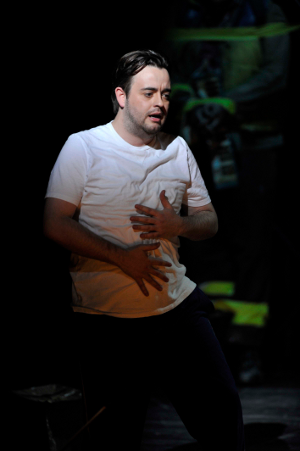 Ben Johnson as Tamino
Ben Johnson as Tamino
Simon McBurney and Complicité create dazzlingly imaginative theatre. Their A Dog's Heart was astonishingly vivid. The opera was a mess but the staging turned it into art. With Mozart, McBurney has infinitely better music, and rises to the challenge. As we hear the Overture, we see a hand write words in chalk on a blackboard. As the opera evolves we learn its significance. Words communicate. We see images of books on shelves, and up to the moment mobile devices. The stage above the stage is a laptop or Notebook. It's suspended on wires from the roof and looks dangerously fragile, but that in itself has meaning. Finn Ross's' video projections are among the best in the business, and extremely well integrated into the drama. Technology may change the ways we express ourselves, but if we don't communicate, or refuse to engage with each other, we're lost. At the end, chalk figures proclaim "WISDOM LOVE". Simple and austere but all the more powerful for that.
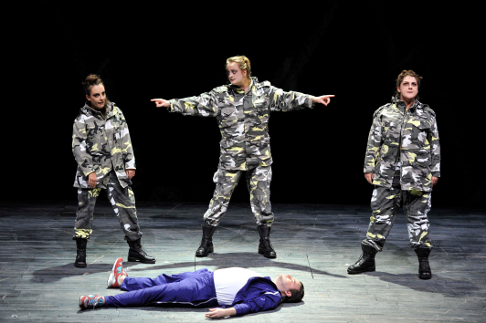 Ben Johnson as Tamino (foreground), Rosie Aldridge, Eleanor Dennis, Clare Presland (L-R background) as the Three Ladies
Ben Johnson as Tamino (foreground), Rosie Aldridge, Eleanor Dennis, Clare Presland (L-R background) as the Three Ladies
Technology changes in theatre, too. Film and computer-generated images break down physical restraints of production and free imaginative possibilities. The Magic Flute IS magic after all, not realism. It cries for cosmic flights of fantasy. McBurney's designer, Michael Levine, gives us the night sky in all its glory : myriad sparkling stars in the firmament. The Queen of the Night (Cornelia Götz) in this production isn't spectacular but the forces she commands most certainly are. Extra-terrestrial sound effects amplify the sense of cosmic spaciousness. Off-stage noises are a natural part of staging. Here they rumble at the edge of consciousness. Gergely Madaras seems spurred to conduct with strong, dramatic flair. This highlighted the quiet moments when the Flute (Katie Bedfiord) emerged. The flute felt all the more magical and fragile. The Flute is more than an instrument. It is fundamental to the meaning of the opera. Like Papageno's bells, it evokes something pure, primeval and plaintive. McBurney's staging was musically as well as visually astute. The "birds" that fly in these woods were pieces of paper fluttering like the pages of books. Like the Flute and the bells, economy of gesture expresses deeper meaning.
This staging is beautiful, revealing its charms obliquely, much as the Singspiel tradition is more subtle than later forms of grand opera, and McBurney respects the vibe. The scene where Tamino and Pamina float, apparently suspended in space, surrounded by "birds" is magical. The English dialogue is genuinely witty. Papageno (Roland Wood) quaffs a bottle of Chateauneuf du papageno!
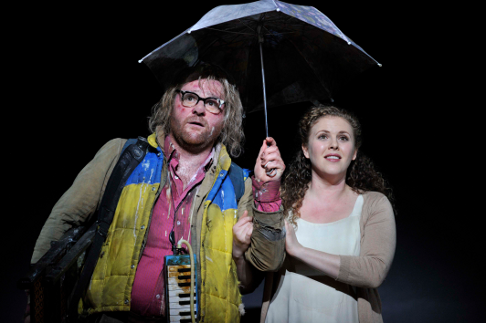 Roland Wood as Papageno and Devon Guthrie as Pamina
Roland Wood as Papageno and Devon Guthrie as Pamina
The singing and acting were also above average for the ENO, hamstrung as it is by the need to do operas in a language other than those for which they were written. This cast delivered with panache, communicating their enthusiasm with style and wit, obliterating the lumpen ENO Die Fledermaus, killed not by the staging but by the performance.
Ben Johnson sang Tamino. He has stage presence..He even looks right, and creates a Tamino with personality, doggedly battling the situation he's in. His firm, assertive singing showed that Tamino is not a spoiled princeling but a man of character and resolve who can face what Sarastro, and the world, throws at him.
Roland Wood sang Papageno, ostensibly the lesser, low-born character in the opera but fundamental to its meaning. Princes abound in classical art, but Mozart gives us Everyman as non-hero in a strikingly modern way. From Papageno we can trace a line through to Siegfried and even to Wozzeck, a role taken by many good Papagenos, and one which Wood is surely destined for. The Papageno songs are harder to carry off than they seem because a singer has to express the role's innate nobility while acting the inept Fool. Spontaneous applause after the Papageno/Papagena duet., and very well deserved indeed. I didn't like the fake provincial accent and Little Britain connotations which English theatre is obsessed with, but Roland Wood's personality shines through the disguise.
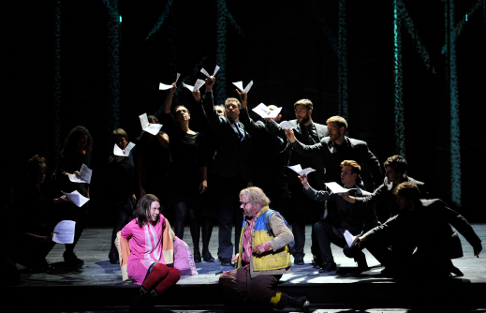 Mary Bevan as Papagena and Roland Wood as Papageno
Mary Bevan as Papagena and Roland Wood as Papageno
Mozart's arias for Sarastro are so resoundingly written that they evoke the idea of Sarastro as a figure beyond time, an acolyte, perhaps, of Egyptian gods. James Cresswell sang the part well, though he didn't quite suggest the complexity of the character: Sarastro has very dark sides. He's an unforgiving judge rather than a father figure. Cornelia Götz sang The Queen of the Night. Here, she's no Darth Vader vamp, as in some stagings, but a surprisingly vulnerable woman. Her Ladies (Eleanor Dennis, Clare Presland, Rosie Aldridge) extend her part. Monostratos (Brian Galliford) conveys the Alberich-like animalism, suggesting that he's a dark cousin of Papageno, gone bad.
Devon Guthrie sang a lovely Tamina and Mary Bevan a spirited, lyrical Papagena. The Three Spirits were Alessio D'Andrea, Finlay A'Court and Alex Karlsson, costumed as ancients, whose Norn-like purpose they serve.
This Magic Flute might confound those who want their Mozart vacuous, but those who truly love the opera will get a lot from this highly individual, perceptive approach.
For more details check the ENO website
Anne Ozorio
image=http://www.operatoday.com/ENO_MF_07.png
image_description=Cornelia Götz as The Queen of the Night [Photo by Robbie Jack courtesy of English National Opera]
product=yes
product_title=The Magic Flute, ENO, London
product_by=A review by Anne Ozorio
product_id=Above: Cornelia Götz as The Queen of the Night
Photos by Robbie Jack courtesy of English National Opera
Britten, Danced.
Britten's Phaedra was made to be moved to. Maze-like, recurring patterns, mirror images. The orchestration is bizarre. It's scored for percussion and harpsichord, with small string ensemble and soprano, Its textures are stark and stylized, with the directness of Greek or Roman art: no fancy background decoration. Percussion and harpsichord? The timpani and metallic instruments add a raw edge, militaristic perhaps, or maybe ceremonial. Phaedra, after all, is a queen and she takes her regal responsibilities seriously. Britten's cycle feels like state treason, (which of course it is). Against the grim percussion, the harpsichord struggles, the thinness of its tone perfectly portrays Phaedra's vulnerability. Harpsichords are percussion instruments too, and Britten makes no pretence at writing anything harmonic or baroque.
Britten's nine songs evolve like tableaux, each a stage in Phaedra's journey from her wedding day to her death. Phaedra's feelings are not love, but a curse. "I faced my flaming executioner Aphrodite, my mother's murderer". Phaedra's mother was Pasiphaë, who slept with the bull and died giving birth to The Minotaur. Kinky. Britten sets the vocal part in a combination of long, soaring arcs and short staccato interspersed with tense silence. "I could not breath or speak", she sings , describing the compulsion that overwhelms her. She rasps, "Love. Love. Love" heavy and hollow like ostinato, against wildly turbulent, twisting discords, marked by high, screaming strings. "Alone" she suddenly shouts : no adornment, no softening. Indeed, by this stage words are bursting out almost randomly, without any attempt to civilize feelings into conventional form.
"Death to the unhappy is no catastrophe" she intones. At last the strings rise in a sort of elegaic anthem, almost recognizably melodic, but quickly surge into a whirring, rushing torrent. "Chills already dark along by boiling veins" Phaedra faces death heroically. In the end, a solo cello plays a sweet, lyrical passage : Phaedra is no more.
The Britten Sinfonia were shrouded in darkness: an atmospheric touch. The music seemed to materialize out of nowhere, like the mysterious workings of Fate that have cursed Phaedra. The dancers of the Richard Alston Dance Company appeared in strict formation: disciplined, unsentimental, like a Greek chorus. Costumes (Fotini Dimou) glowed scarlet like blood, purple like Phoenician royal. Hippolytus (Ihsaan de Banya) dances among his friends. He's magnificent - so muscular, so lithe, so physical. Phaedra (Allison Cook) is smitten. Because the music moves in tableaux, there are opportunities for different ensembles. Pekka Kuuisto's violin was particularly evocative, suggesting sensual, but sinister curves. Kuuisto's strong, charismatic personality makes an impact even when he's in the background. The dancers weaved languidly when he played, then snapped into fierce angular stances, as stylized and unyielding as the music itself. Alston also made more of the role of Theseus (James Muller) and Oenone (Nancy Nerantzi), fleshing out the drama as counterparts to Phaedra and Hippolytus.
Cook isn't a singer of the calibre of Janet Baker or Sarah Connolly, but she moves well.. Simon Keenlyside, an athlete and dance devotee, used to specialize in singing with dancers, an art which is quite different from just singing. He moved in sympathy with the dancers, without affecting his singing. Cook projected impressively, and made the part convincing.
The Barbican Centre also commisioned choreography for Britten's Sechs Hölderin Lieder. Dance is episoidic by nature, so songs lend themselves well to small scale scenas. The dancing was pleasant enough but these songs are far too condensed and complex to translate into movement. Their rhythmic pulse also compromises the piano line and the singing. RobinTritschler and Christopher Glynn needed to be more flexible and fluid, especially since the dancers were so lyrical.
Richard Alston's choreography of Illuminations was first created for Aldeburgh in 1994, titled "Rumours, Visions". (a quote from the final song Départ), together with Alston's Lachyrmae, which opened the evening at the Barbican. In Illuminations, Alston also creates protagonists Rimbaud (Liam Riddick) and Verlaine (Nathan Goodman) and the muse, in Being Beautous, was Elly Braund. These characters don't, strictly speaking, appear in the text, but give a danced performance dramatic context. Rimbaud and Verlaine had a torrid affair which shook provincial society. They escaped to London, then the most modern, cosmopolitan city in the world. Rimbaud was fascinated by the mechanical processes of city life. Dance brings out the subtle recurring patterns in the music, often obscured by the sheer brilliance of virtuoso performance. But therein lies the contradiction of interpreting a piece through a different medium. If the singing is too good, or too idiomatic, it draws attention away from the dance. Tritschler's voice is low for the piece, with a tendency to sing under the note, struggling at the top. Les Illuminations needs a soprano, or a very specific kind of high "Britten tenor" to bring out the surreal craziness in the piece. It also didn't help that the performance was over-miked, any subtle nuance drowned by sheer volume. But the audience at the Barbican Theatre, most of whom seemed to be dance people, were delighted, because the music served the dance. That's as it should be. We can listen to Les Illuminations any time, but we don't often get to see it danced.
Richard Alston Dance Company's Barbican Britten; Phaedra is part of Barbican Britten, a two week celebration of Britten's centenary that examiness Britten's music from stimulating new perspectives.
Anne Ozorio
image
image_description
product=yes
product_title=Benjamin Britten, Richard Alston Dance Company, Barbican theatre, London 6th November 2013
product_by=A review by Anne Ozorio
product_id
November 7, 2013
Madama Butterfly, Chicago
This exposure of the individual characters, their hopes and conflicts, requires that the performers communicate musically in the midst of shifting narrative turns and a gamut of anguished feelings. The original production was directed by Michael Grandage with sets and costumes by Christopher Oram; for Chicago the production is directed by Louisa Muller. Cio-Cio-San / Butterfly and Lieutenant B.F. Pinkerton are sung by Amanda Echalaz and James Valenti, both making house debuts. Butterfly’s attendant Suzuki is performed by Maryann McCormick and the American Consul Sharpless by Christopher Purves, the latter also appearing here for the first time. The Lyric Opera Orchestra is led by Marco Armiliato, who makes his Chicago Lyric conducting debut with these performances.
At the start of Act One the Japanese marriage broker Goro, sung by David Cangelosi, and Pinkerton discuss business matters relating to the house which the protagonist has rented for his current relationship with Cio-Cio-San. When describing both the household members in the service of the bride, and guests who will attend the ceremony with Pinkerton, Cangelosi’s Goro is masterfully acted and sung with obsequious gestures and with a good sense of idiomatic delivery. Mr. Valenti’s Pinkerton seems appropriately distracted when hearing Goro’s recitation of domestic details. Valenti’s facial expression remained unchanged during this scene and the following exchange with Sharpless who enters in a breathless rush to witness on site Pinkerton’s plans. Valenti’s lyrical spirit emerges when he sings “Dovunque al mondo’ (“Everywhere in the world”) in his soliloquy to Sharpless on the wandering and risk-taking Yankee sailor. It is surely this attempt to stay in character, seeking pleasure until he settles someday with a proper “sposa americana,” that explains Valenti’s grinning stage demeanor and understated vocal line. At times both he and Purves’s Sharpless were unfortunately challenged in their vocal projection by overly vigorous orchestral volume.
As Cio-Cio-San enters with her companions, the excitedness of the young women is appreciated by their host. Despite her own demure behavior vis-à-vis Pinkerton this Butterfly is skilled at giving orders to her retinue of serving companions. Ms. Echalaz sings with secure pitch, at first investing her line with a noticeable amount of vibrato as a means to expressing her mix of ardor and nervous expectation. Once her character feels more comfortable in this conjugal setting, to which she assigns blind faith, Echalaz varies the expression of vocal color. She describes her few treasured possessions with a nonchalant tone for the pot of rouge, yet her description of the “cosa sacra” (“sacred possession”) — the knife of her father’s suicide — is pronounced with pure, unwavering focus. Once the Bonze, uncle of Cio-Cio-San and a Buddhist priest, enters and curses her resolve, the ultimate societal and personal isolation of the young woman has begun. As the Bonze, David Govertsen delivered an appropriately menacing and lyrically convincing impression, while also competing with an unyielding orchestral force. The departure of authorities and extended family leave the protagonists alone for perhaps their most celebrated expressive music in Puccini’s score. Valenti and Echalaz sang this duet touchingly from his rising vocal line on “Viene la sera” (“The night approaches”) to Butterfly’s naïve pronouncements “Ah dolce notte! quante stelle!” (“Oh, beautiful night! So many stars!”). At times during this first and the following acts the voices seemed muffled as though the set, constructed of graduated panels, were absorbing some of the performers’ vocal projection.
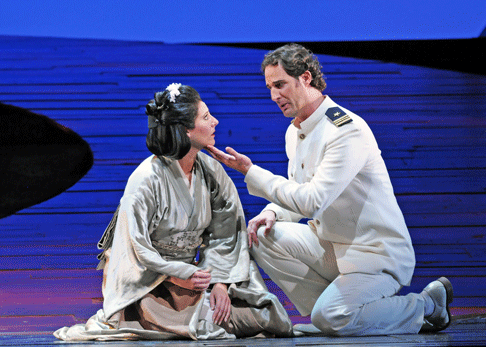 Amanda Echalaz as Butterfly and James Valenti as Pinkerton
Amanda Echalaz as Butterfly and James Valenti as Pinkerton
Act Two of Madama Butterfly begins as an extended duet for Cio-Cio-San and Suzuki, the latter despairing over the failure of Pinkerton to return within three years. Ms. McCormick’s Suzuki featured some of the most expressive dramatic singing of this performance, as she released rich, dark pitches in her warnings of their precarious financial household. In reply Cio-Cio-San’s famous aria “Un bel di” (“One fine day”), assuring her faith in Pinkerton’s return, was sung with careful attention to top notes alternating with lines sung piano for their introspective emphasis. Sharpless interrupts this intimate scene and tries repeatedly to communicate the contents of Pinkerton’s letter. Purves’s Counsul showed the ideal mix of anguish and frustration in both acting and singing as he tries to broach the topic with Butterfly. Once the cannon-shot is sounded, Butterfly is again lost in her world of determined faith: she and her child, with Suzuki joining in support, scatter flower petals to signal their welcome of Pinkerton.
The “Humming Chorus” performed between Acts Two and Three was subtly audible as the central structure of the stage revolved. In the final scenes Echalaz’s descent into renunciation of her life and child was as complete as her earlier trajectory of hope. Pinkerton’s brief appearance and aria, “Addio, fiorito asil,” (“Farewell, flowery refuge”) was here sung by Valenti with the ability to integrate this vocal piece into the dramatic flow. His brief lyrical outburst simply added in this production to the tragedy as Madam Butterfly proceeds to the decision that she realizes is now inevitable.
Salvatore Calomino
Click here for cast and production information.
image=http://www.operatoday.com/MADAMA_BUTTERFLY_DBR_5025.gif image_description=Amanda Echalaz as Butterfly [Photo by Dan Rest/Lyric Opera of Chicago] product=yes product_title=Madama Butterfly, Chicago product_by=A review by Salvatore Calomino product_id=Above: Amanda Echalaz as ButterflyPhotos by Dan Rest/Lyric Opera of Chicago
Maestro Joseph Rescigno Discusses The Flying Dutchman
On October 25, 2013, I spoke with Maestro Joseph Rescigno who will be conducting Richard Wagner’s The Flying Dutchman at Arizona Opera beginning November 15th. The cast includes Mark Delavan as The Dutchman, Lori Phillips as Senta, and Raymond Aceto as Daland. The director is Bernard Uzan. Mo. Rescigno told me that the production was designed to have the orchestra pit covered with stage flooring so that the singers would be much closer to the audience.
MN: Does it make the production easier to put together?
JR: No, in some ways it’s harder. Since the singers will be behind me, they will only see me on the TV monitors. I will be upstage with the orchestra and there will be a scrim behind me. The singers are downstage and the scenery consists of moving and still projections. I did Tristan and Isolde like this in 2004 and it turned out very well. I wouldn’t consider this kind of staging for something that’s really fast moving like Rossini or Mozart, but for Wagner it can work. I can remember a whole season of opera produced that way in Washington, DC, when the theater was being renovated.
MN: How do you see The Flying Dutchman? Of what should the listener be aware?
JR: This is my third production. The first two were in the late nineties. It’s a transitional piece because Wagner was only beginning to establish his style. He took some aspects from Carl Maria von Weber and others from Italian composers like Vincenzo Bellini. For me, there is a fine line between those styles. It’s important not to do The Dutchman in a ponderous manner. It has an early romantic feel to it, but at the same time it has moments of greater drama and intensity than Bellini ever gave us.
There are quite a few places where rubato is warranted. Such momentary “tempo bending” for expressive purposes would be entirely in keeping with Wagner’s own comments about his music and the influence the Italians had on him. That is pretty evident in this opera. For example, in the scene where Senta sees the Dutchman for the first time, the orchestra plays while the singers stand transfixed. Then Daland sings an aria and some snippets of the Senta-Dutchman music come into it. When they do, I like to bring back the earlier tempo. It gives variety to the scene and makes subliminal connections across sections. Also, in certain sections, we can be guided by the musical form.
When you look at Senta’s Ballad along with ballads by Chopin and Brahms, you know that kind of music has a certain tempo. When done too slow, it becomes ponderous. It is helpful, of course, that Wagner gave metronome settings for this opera. For example, the ballad is marked sixty-three. (Maestro sang the first line: “Trafft ihr das Schiff” with a pleasant lyric baritone sound). That tempo is important for the ballad.
I need different tempi to establish the dances: At the end of the first act there is a type of sailor’s Hornpipe. (Maestro sings a little bit of it). Wagner would develop his style further in his next few operas. All of this is a wonderful amalgam of the older styles of Bellini and von Weber mixed with Wagner’s own nascent style which he crystalizes in The Ring of the Nibelungen and Tristan. If you understand this, you won’t take the dances too fast.
MN: Who were some of your favorite artists of the past?
JR: One of them was Leonie Rysanek whom I saw in many roles. She had an enormous amount of energy and intensity. Her presence on the stage created excitement. Over the past twenty-five years I think there has been much too much emphasis on the elimination of mistakes and not enough on individual interpretation. I think it’s one of the reasons we don’t hear many recitals any more. It used to be that when you heard Claudio Arrau and Vladimir Horowitz play the same piece, their interpretations were entirely different. When you heard George Szell and Leonard Bernstein conduct the same work, each of them put his distinctive imprint on it. Now far more artists have similar interpretations and similar sounds.
One of my favorite tenors was Giuseppe di Stefano. I often went to hear him when I was young and I was lucky enough to have conducted his last operatic appearance in 1980. These artists had huge personalities. Who cares if there was a wrong note here or there? Their performances were thrilling. I would not complain about a few sharp or flat notes in any performance by Callas or Rysanek.
MN: What do you think of the current role of competitions?
JR: These days, everything has devolved into a contest. Music is not a contest. Neither is cooking. Now, the winner on a cooking show is the one who prepared the best dish using garlic, oranges, and licorice!
MN: Do you like to cook?
Yes. I love food and I enjoy preparing it, sometimes for a special occasion and sometimes to relax. My specialties are risotto alla Milanese, spaghetti carbonara, and seafood.
MN: Did you study music privately while you were in college?
JR: Yes, I did, and I think it is important for a conductor to study composition and become totally proficient on an instrument. I studied piano with Ada Kopetz-Korf and composition with Nicholas Flagello while I was an undergraduate at Fordham University. After that, I went on to graduate school at the Manhattan School of Music.
MN: Did you have a relationship with the New York City Opera (NYCO)?
JR: I made my debut there in 1985, and between 1999 and 2007 I conducted a production there almost every season. For a musician growing up in that city, the company was always just “there.” It was one of those companies that the city’s music lovers never imagined could actually disappear. While it was not among the companies from which I got my first big breaks, it served that important role for many, many musicians and, therefore, for my industry. Its loss is extremely painful.
During the 2008-2009 season, when the New York State Theater was closed for renovations, the company gave only two performances, but reportedly paid members of the chorus, orchestra, and administration their full annual salaries. By the time George Steele arrived it was already too late to save the company, so I would not pass any judgment on what he did.
The demise of NYCO is a real tragedy. One of my first jobs out of graduate school was as the assistant to Laszlo Halasz, its founder. The creation of the company happened with the support and prodding of Mayor Fiorello LaGuardia at about the same time that he helped create the New York City Ballet with Lincoln Kirstein, and the long defunct New York City Symphony with Leonard Bernstein. The mission of all of these companies was to provide quality performances of both traditional and contemporary opera for the people of the city who could not afford expensive tickets.
MN: Did your uncle, Nicola Rescigno, help you get started?
JR: Yes, he recommended me for the Dallas Opera student performances, which I conducted from 1976 to 1981. I also owe my start at the Florentine Opera in Milwaukee to him. When the Dallas stage manager became the general director at Florentine, he called my uncle and asked him to conduct La Gioconda. My uncle could not do it and he recommended me since I had conducted it the previous year. Not too much later the artistic director resigned and they invited me to assume that position. I’ve been there ever since.
MN: What are some of your favorite operas?
JR: I love Don Giovanni, Die Walkure, Falstaff, and Otello. I’ve never done a Benjamin Britten opera, but I have done an early song cycle of his and his Serenade for Tenor, Horn and Strings. I’d love to conduct Peter Grimes and The Rape of Lucretia. The story of the latter is somewhat problematic, but the music is fantastic.
image=http://www.operatoday.com/Resigno.gif image_description=Joseph Rescigno [Photo by Christian Steiner] product=yes product_title=Maestro Joseph Rescigno Discusses The Flying Dutchman product_by=An interview by Maria Nockin product_id=Above: Joseph Rescigno [Photo by Christian Steiner]The (Amazing) Nose
And no wonder! The three act work, performed in a single two hour sitting, offers its audiences an unflinching, unremitting, intriguing, absurdist panorama of sight and sound.
What is it about? Let me put it this way. Have you ever, in a moment of cultural delirium thought of what Nicolai Gogol and Dmitri Shostakovich’s Nose and Jerry Seinfeld might have in common? If you said, “Nothing,” you’d be absolutely, perfectly right. Proof: D.S. Mirsky, the late Russian literary critic, wrote, “In [The Nose] more than anywhere else Gogol displays his extraordinary magic power of making great comic art out of nothing.” And you know how the Seinfeld show has been touted. Where Gogol and Shostakovich part company with Seinfeld’s “nothingness” is in their sharper, less charitable and tolerant views of human frailties.
Excerpt from Scene 3 (Act I)
So one day a barber discovers the nose of one of his customers — a self centered, unmarried petty official, in a freshly baked roll. The baker’s attempts to dispose of it meet with failure. The nose escapes and creates a highly successful and joyful life for itself. Really and truly, there’s a nose with legs prancing about the stage. Meanwhile, waking to discover his loss, the distraught official, named Kovalyov (please note that his first name is Platon (Plato) attempts to recover his appendage. Of course, you’d go to the police or advertise for information in a newspaper if that happened to you) But no one seems inclined to deal seriously with Kovalyov’s quest. And when he encounters his nose in church, the haughty appendage, having achieved even higher bureaucratic status than his own, refuses to discuss the matter with him. But fear not, there’s a happy ending.
Shostakovitch, who was born in 1906, completed The Nose when he was only 22. An exceptional pianist, he had been admitted to the St Petersburg conservatory at 13, by its director Alexander Glazunov, and was known there for his good spirits, love of language and literature, and an interest in the absurd. Those were the early years of the Russian revolution, marked with new freedom for composers, as for all artists anxious to cut loose from bourgeois values. Shostakovich’s operatic pen ran rampant. In addition to using popular and folk tunes, and writing voice parts for more than seventy roles, he created a virtual non stop orchestral display of dissonance, spikey intervals, bizarre rhythms, and extraordinary percussive interludes that presage the enormously powerful percussive effects found in his later scores. One way to appreciate the composer’s interpretative achievement is to read the Gogol story. Gogol’s satiric voice, his descriptions of the attitudes and thoughts of its many characters, are clearly translated into Shostakovich’s antic music. Nevertheless, instead of the pleasure the young composer might have anticipated from the work, it immediately brought denunciation, the first of many his native land was to heap on him. The opera was considered “formalist” — too western, too modern, too elitist for peasants and workers. A staged performance in 1930, only reinforced official condemnation and The Nose was not performed in the Soviet Union until just month’s before Shostakovich’s death.
Excerpt from Scene 4 (Act I)
But please don’t listen to The Nose for its music. That’s not my advice. It’s Shostakovich’s. He disapproved of presenting the 1929 concert version of The Nose . “The Nose loses all meaning if it is seen just as a musical composition. The music springs only from the action. It is clear to me that a concert performance of The Nose will destroy it.”
William Kentridge, the South African artist, who suggested The Nose for his debut production with the Metropolitan Opera, is a man attuned to the grotesquery and absurdism of story and score - clearly kindred to the writer and composer. As with Shostakovich’s music, one is hard pressed to detail the individual elements or inventive combination of techniques which energized Kentridge’s production. Under Kentridge’s and Luc De Wit’s direction, with sets designed by Kentridge and Sabine Theunissen, the stage was in perpetual motion for two hours. The nose was a black silhouette, a white triangle with human legs. It rode horses, traveled in carriages, went to church. Cubbyhole rooms morphed into huge panoramic scenes. In a brilliant touch, Kentridge stacked narrow minded newspaper people vertically at desks on a center stage panel. Projections, prints, banners, newspapers, old film, sometimes layered one atop another, sometimes giving way to one another, sometimes in English, sometimes in Russian, filled the background of the stage. Projected silhouettes of Anna Pavlova with the large nose as her head, dancing each time Kovalyov tried to reattach the small restored nose to his face, were particularly comical. Among the amusing costumes by Greta Goiris, were the soldiers gray uniforms “armed” with huge red panels at the back, with which they beat the giant nose down to decent facial size, and the “bagel lady’s” hoops, adorned with the names of her wares in Russian and English. My only objection to all that nonstop visual fun was that it difficult to focus much attention on the music. Fortunately, I was able to see the opera twice.
The opera was sung in Russian. The primary role of Kovalyov was taken by Paulo Szot, who also sang the role in the Met’s 2010 production. In addition to his mellifluous baritone, Szot’s comical acting was pitch perfect in what could be an overdone farcical role. Andrey Popov, who sang the police inspector in a punishing tenor tessitura just one degree south of shouting, which Shostakovich thought appropriate for a haughty police person, delivered his lines with clarity and aplomb. Australian Alexander Lewis was properly elegant when required to represent the proboscis as a person with a tenor voice. Vladimir Ognovenko, a bass who has sung commanding roles such as Boris and Mefistofeles, was a splendidly unpleasant barber. And Ying Fang, a member of the Metropolitan Opera’s Lindemann Young Artist Development Program made a charming debut in the opera’s only extended lyric moments, as a young woman to whom Kovalyov is attracted. Conductor Pavel Smelkov, himself a composer, who had previously conducted the opera at the Met and elsewhere, led a crisp performance.
Orchestral interlude from Act I
One last sentimental note about Shostakovich and The Nose. The opera remained one of the composer’s favorite works. He is said to have judged people by their fondness for it. When it was revived in the Soviet Union nearly fifty years after it’s first and only performance, Shostakovich attended rehearsals and the premiere. There is a poignant You Tube video on the Internet (which dates the rehearsal in 1975) showing not only segments of that performance, but the dour 69 year old composer at the rehearsal eventually singing the words, then smiling and finally moving to the music. At the conclusion he rises to accept thunderous applause. Shostakovich died in August of 1975.
Estelle Gilson
Cast and production information:
Kovalyov:Paolo Szot; Police Inspector:Anfrey Popov; The Nose:Anthony Lewis. Conductor:Pavel Smelkov. Production: William Kentridge. Stage Directors: William Kentridge and Luc De Wit. Set Designers: William Kentridge and Sabine Theuunissen. Costume Designer:Greta Goiris. Video Compositor and Editor: Katherine Meyburgh. Lighting Designer: Urs Schönebaum.
image=http://www.operatoday.com/Nose_Met_2013_01.gif image_description=Dina Rose Rivera as A Pretty Lady and Paulo Szot as Kovalyov [Photo by Ken Howard/Metropolitan Opera] product=yes product_title=Amazing Nose product_by=A review by Estelle Gilson product_id=Above: Dina Rose Rivera as A Pretty Lady and Paulo Szot as Kovalyov [Photo by Ken Howard/Metropolitan Opera]November 5, 2013
Death in Venice, Festival of Britten
The strongest aspect for me is the way Oida economically and simply makes it palpably clear that the shocking demise that we witness, as esteemed writer, Gustav von Aschenbach, falls from his literary podium and sinks into disrepute and decay, is a case of deliberate or subconsciously willed self-destruction. Fatally lured by his alter ego — a fictitious composite figure, who is a reflection of Aschenbach’s desires, fantasies and uncertainties, and the very emblem of what he fears he may himself become — it is clear from the first that the die is cast for Aschenbach, his fate determined by his own failings: egoism, repression and self-denial.
So, in Oida’s production, before a note is played the mysterious Traveller takes his place in the cemetery, awaiting his victim, his overcoat and hat a mirror image of his prey’s attire. The wreath that he lays, as splash of colour amid otherwise monotone hues, is both a monument to a deceased artist’s creative achievement and a mocking foreshadowing of Aschenbach’s actual death. As the drama ensues, the doppelgänger will at times watch from the side-lines — symmetrically counter-balancing Aschenbach as he lounges in his deckchair admiring the foreign tourists who play and parade along the Lido — and, as he takes his fancy, enter into the action, effortlessly directing the protagonist to his doom. He does not conceal his deceit, changing his costume before our eyes. He dons the garish blazer of the Elderly Fop, the hooded mantle of the Gondolier, the smart suit of the Hotel Manager, the crisp white overalls of the Hotel Barber and the lurid, velvet checked robe of the Leader of the Players, but always he is the voice of Dionysus, overpowering Apollo with his Bacchanalian song.
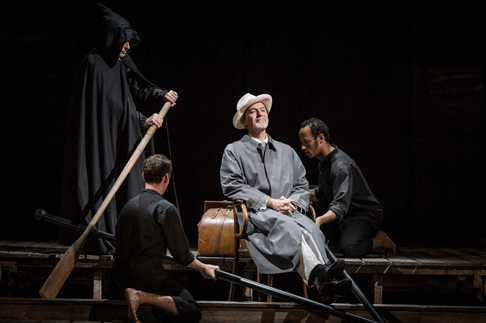 Alan Oke as Gustav von Aschenbach, Peter Savidge as the Old Gondolier
Alan Oke as Gustav von Aschenbach, Peter Savidge as the Old Gondolier
At this performance in the Snape Maltings concert hall, baritone Peter Savidge was absolutely superb as the multifarious tempter. His first phrase, ‘Marvels unfold’ was simultaneously alluring and menacing; his ghastly falsetto ‘Serenissima’ squeals were disturbingly insincere. Sneering, Savidge contemptuously emphasised Gustav von Aschenbach as he ‘welcomed’ the writer to his hotel, inferring his scorn for the writer’s reputation, wounding his already fragile self-worth. The Leader of the Players’ dissembling crooning whipped up a cacophony of shrieks, the very laughter of the devil, from the observing restaurant clientele; with rude, defiant mockery he refused to answer Aschenbach’s enquiries about the plague infecting Venice’s canals, but his departing, Mephistophelian glower, unexpected and appalling, left us in no doubt of the peril to be faced. Imperious and manipulative as the Barber, Savidge ultimately removed his workday wear to reveal once more the loud stripes of the Elderly Fop’s jacket and, derisively twirling his ebony cane, presented Aschenbach with a soul-destroying reflection of himself. The baritone adopted every dramatic and musical mode with attentiveness and confidence, slipping from persona to persona with disturbing ease.
Of course the principal spotlight is on Aschenbach himself, and in the title role tenor Alan Oke sang with compelling dignity and clarity. Despite a tendency to sing under the note, Oke found a range of colours which drew us into the character’s experience — no mean feat given the prosaic verbosity of much of Myfanwy Piper’s libretto, the irony third-person narrative of Thomas Mann replaced by solipsistic soliloquising. Thus, Oke’s opening recitatives were delivered in a sensitive mezza voce, and then he surprised us, booming his own name magisterially, shoring up his own identity before its imminent and inevitable collapse. When this passage was recalled in the final scene of the opera, the hollowness of tone was poignantly indicative of what has been lost.
The opening scenes felt rather slow — but that’s not Oke’s fault, things don’t really get going musically until the second Act — but he brought a wonderful, yet frighteningly ominous, relaxation to the self-admission, ‘So be it, so be it’, when Aschenbach determines to stay in Venice. Such emotional release rendered the end of Act 1 even more poignant as Aschenbach splashed in the waters, intoxicated by the alien flood of passion in which will soon wallow — his ruined shoes a pitiful forewarning of his ruined heart — before staggering from the stage, in silence, his steps mirrored by the knowing tread of the Traveller.
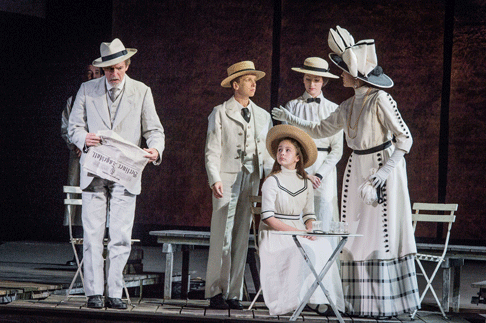 Alan Oke as Gustav von Aschenbach, Emily Mézières as Tadzio, Riikka Läser as A Polish Mother, and Marie-Charlotte Chevalier as the Governess
Alan Oke as Gustav von Aschenbach, Emily Mézières as Tadzio, Riikka Läser as A Polish Mother, and Marie-Charlotte Chevalier as the Governess
The large cast was uniformly assured. As the English Clerk, Damian Thantrey’s confirmed that the cholera outbreak had taken hold with indisputable, clarion-like authority. Kathryn Stevens’ lustrous tone was even more ironic on the second occasion that she tempted Aschenbach with her baskets of sweet strawberries, the ripe juices now turned to toxin. In the smaller roles, David Llewellyn (Hotel Porter), Paul Gibson (Hotel Waiter) and Victoria Sharp (A newspaper-seller) sang with precision and character.
Tom Schenk’s set designs exploit the natural fabrics of the Maltings Hall for which the production was designed: a russet brick backdrop — perhaps the disintegrating walls of the buildings that line the putrid Venetian canals — and plain, raised wooden platforms, suggestive of the decking and promenades of the Lido. Paule Constable’s lighting scheme swathes the stage in a range of atmospheric tints: aquamarine blue evokes the glint of sun on glassy waves; soft yellow warms the youthful beach-side sports; cool purple suggests Aschenbach’s alienation from the tourists’ relaxed sojourns; blood-red illuminates the more Hadean moments. Aschenbach’s soliloquies are accompanied by a shrinking of the span of light to a bright white spot which glares down directly from above, unsparingly illuminating his self-deceptions and misery.
Sometimes things feel rather too ritualised. Two black-jinbei clad actors (costumes, Richard Hudson) move chairs and other props with ceremonial poise, at times miming a gondoliers’ balletic dance, on occasion their punting poles turning into burning torches, lighting Aschenbach’s passage to hell. At other points, they seat themselves at the sides or facing upstage, passive squatting Buddhas. As the Old Gondolier — an ebony-cloaked Charon — speeds the writer to his destiny, white-clad ferryman enact a slow t’ai chi-style routine. The dance sequences themselves seem overly long, but this is probably unavoidable and Daniel Kurz’s choreography effectively emphasises athletic power and grace; there is nothing sexually suggestive about the muscular routines, and the playful splashing in the water which laps beneath the wooden platforms suggests freedom and lightness of spirit.
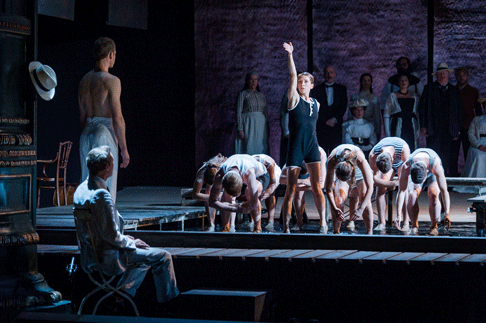 Alan Oke as Gustav von Aschenbach, Christopher Ainslie as the Voice of Apollo, Emily Mézières as Tadzio, Dancers: Claire Burrell, Danilo Caruso, Marie-Charlotte Chevalier, Anna Chirescu, Mark Farrant, Daniel James Greenway, Jamie Higgins, Eithne, John Ross, Tom Neill, Pablo Woodward, and the Chorus of Opera North
Alan Oke as Gustav von Aschenbach, Christopher Ainslie as the Voice of Apollo, Emily Mézières as Tadzio, Dancers: Claire Burrell, Danilo Caruso, Marie-Charlotte Chevalier, Anna Chirescu, Mark Farrant, Daniel James Greenway, Jamie Higgins, Eithne, John Ross, Tom Neill, Pablo Woodward, and the Chorus of Opera North
However, I really can’t understand the casting of Tadzio: Emily Mézières danced with lithe elegance but, while she may be of androgynous physique she does not possess a male adolescent’s muscular presence. Including female dancers among the exuberant band of carefree holidaying companions upsets the balance a little, but would be tolerable; but, Mézières, for all her agility and physical eloquence simply does not stand out sufficiently from the crowd — she embodies neither conventional feminine ‘allure’ nor the knowing charm of a confident male pubescent. Almost asexual, it was not at all clear why such a figure would drive Aschenbach to self-annihilation.
This anomaly was most striking at the end of Act 1, when Christopher Ainslie’s imposing, noble Apollo was not just heard but also seen during the youthful pentathlon: the text he sings, with resonating directness, reminds us of Plato’s theories of Beauty, but the decision to cast a female dancer as Tadzio runs counter to the Hellenism in the libretto, a dimension which is expressed even more strongly in Mann’s novella.
Where the ‘ritual’ does work, however, is during some of the choral and ensemble scenes. The families from Russia, Germany, Denmark and other nations are often assembled like a picture postcard or still life, as time stagnates for Aschenbach while the dancers provide a vigorous counterpoint to his sterility. During the Dream sequence, the crowds arrange themselves at the front of the stage, and as Apollo extinguishes his burning staff, his purifying flames defeated by Dionysus’ licentious energy, the onlookers are infected by the latter’s dissolution and their rising cries become the unbridled voice of Aschenbach’s own moral recklessness.
During this Dream passage the playing of the Orchestra of Opera North was terrifyingly vivid. In the first Act the contrast between the dry pianism which accompanies Aschenbach’s arioso and the lushness of the ‘Serenissima’ motifs and Tadzio’s gamelan-like exoticism seemed underplayed, and the view motif scarcely registered. But conductor Richard Farnes pulled out the stops after the interval, and there was much striking and accomplished playing, particularly in the instrumental passage at the start of Act 2, with its deep, dissonant pedal disturbing the orchestral sweetness above.
As he begins, it is with silence that Oida ends. Once the final notes of the score have faded and the lights have dimmed, Oke rises and leaves the stage with ponderous resignation; it is hard to imagine closing moments which could more painfully expose human frailty.
Claire Seymour
Cast and production information:
Gustav von Aschenbach, Alan Oke; Traveller, Peter Savidge; Voice of Apollo, Christopher Ainslie; English Clerk, Damian Thantrey; A Polish mother, Rükka Läser; Tadzio, Emily Mézières; Dancers, Claire Burrell, Danilo Caruso, Marie-Charlotte Chevalier, Anna Chirescu, Mark Farrant, Daniel James Greenway, Jamie Higgins, Eithne Kane, John Ross; Actors, Tom Neill, Pablo Woodward; Ship’s steward and Restaurant Waiter, Dean Robinson; Hotel Porter, David Llewellyn; Lido Boatman and Hotel Waiter, Paul Gibson; A French mother, Vivienne Bailey; French daughter, Sarah Blood; A German mother, Hazel Croft; A German father, Stephen Dowson; First American, Peter Bodenham; Second American, Stephen Briggs; A Polish father, Edward Thornton; A Danish lady, Rachel J Mosley; An English lady, Miranda Bevin; A Russian mother and A newspaper-seller, Victoria Sharp; A Russian father, Gordon D Shaw; A Russian nanny, Cordelia Fish; A guide in Venice, Nicholas Butterfield; A lace-seller, Sarah Estill; A glass-maker, Campbell Russell; A beggar woman, Claire Pascoe; Gondoliers, Arwel Price, Jeremy Peaker, Paul Rendall; A priest in St Mark’s, Edward Thornton; Strolling Players, Gillene Butterfield, Nicholas Watts; Director, Yoshi Oida; Conductor, Richard Farnes; Revival director; Rob Kearley; Set designer, Tom Schenk; Costume designer, Richard Hudson; Lighting designer, Paule Constable; Choreographer, Daniela Kurz; Revival choreographer, Katharina Bader; The Orchestra of Opera North. Snape Maltings, Aldeburgh, Saturday 2nd November 2013.
image=http://www.operatoday.com/Death-in-Venice-04.gif image_description=Alan Oke as Gustav von Aschenbach [Photo by Robert Workman] product=yes product_title=Death in Venice, Festival of Britten product_by=A review by Claire Seymour product_id=Above: Alan Oke as Gustav von AschenbachPhotos by Robert Workman courtesy of Opera North
“T” as in “Terrific Toronto”
From the moment Tom Corbeil opened his mouth as Swallow at the start of Peter Grimes, I knew we were in for a special night. For Mr. Corbeil not only boasts a smoky-hued bass-baritone of real distinction but he sings with real dramatic insight. Where other Swallow’s have been content to be large-and-in-charge, barking for volume as they accuse the title character, this young singer found more strength in understatement, more power in variety. That is not to say he cannot sing with commanding strength and security, just that he wisely chose to be selective. From this auspicious beginning, the performances just went from strength to strength.
Alan Held’s Balstrode is a towering achievement. I might have said “colossal” but I may have said that the last time I encountered this consistently fine artist. Mr. Held once again unleashed his enormous, pointed sound to etch a finely shaded performance. As Ellen, Ileana Montalbetti’s creamy soprano sounded lush and even in melismatic passages, and she found real spinto heft for the more contentious exchanges. Her Embroidery Aria may be the finest I have yet heard, her limpid phrasings underpinned with melancholy.
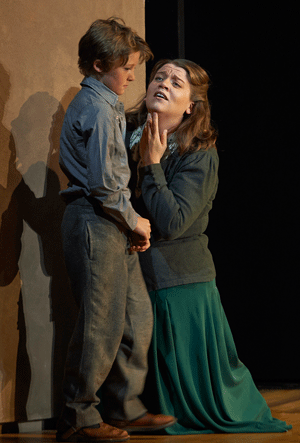 Jakob Janutka as John, Peter Grimes’s apprentice, and Ileana Montalbetti as Ellen Orford
Jakob Janutka as John, Peter Grimes’s apprentice, and Ileana Montalbetti as Ellen Orford
Jill Grove was a forceful, no-holds-barred Auntie with a full-bodied chest voice wedded to a lower- and upper-middle that rang out in the house. In addition to a superior technique, Ms. Grove also sported the best diction I have ever heard from anyone in this part. Ileana and Jill were also stellar in one of the evening’s highlights, as their voices effortlessly intertwined in the famous quartet, complemented by COC Ensemble Studio’s Claire de Sévigné and Danielle MacMillan as Nieces 1 and 2, respectively. These two fine sopranos are proof positive that that young artist development program is such a fine investment.
Veteran Judith Christin does not miss a trick as the meddling Mrs. Sedley. Like Fedora Barbieri before her, she overcame time’s diminishment of her lower register by pouring on the steam in the chest and upper register and using her years of experienced stage moxie to wend through the rest without losing meaning or continuity. Roger Honeywell was luxury casting as Bob Boles. Mr. Honeywell sang the title role himself to great acclaim this summer in Des Moines. As Boles, his steely tenor has never sounded better. Indeed his tone was more elastic, pliable, and easily produced than in previous encounters. This was surely the finest Boles you can imagine hearing.
Peter Barrett was a handsome Ned Keene, and his strapping appearance was married to a virile, gleaming baritone that easily captured the many facets of Ned's carousing personality. Ensemble Studio’s Owen McCausland created a memorable Reverend Adams with his pure tenor and clean projection (attributes that also benefited his Parpignol the next night). Little Jakob Janutka was haunting as the abused apprentice John.
At the show’s heart, Ben Heppner’s Grimes proved to be more earth-bound than some interpreters. His tortured, hulking, hangdog fisherman was not so much a demented loose cannon as a calculated brute. His final great rant was almost more a lament than a mad scene. On his highly individualized terms, Mr. Heppner’s interpretation worked handsomely, with his character’s arc consistent and moving. He decisively surmounted all of the vocal challenges of the part. Ben’s weighty lyric voice is now marked by an occasional huskiness, and beauty of tone was occasionally sacrificed in order to nail a high note. But in this role, at his age, a few rough edges are more ‘patina’ than ‘problematic.’ Ben Heppner remains one of the finest Grimes in the world today.
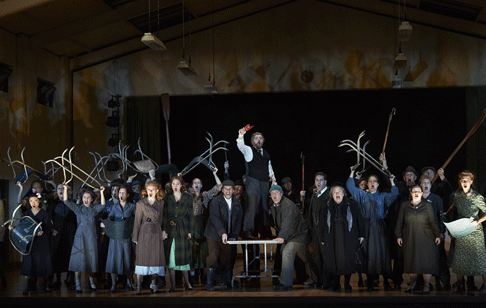 A scene from Peter Grimes
A scene from Peter Grimes
Director Neil Armfield has concocted a fascinating concept with outstanding assistance from his production team: Ralph Myers (Set Design), Tess Schofield (Costume Design), and Damien Cooper (Lighting Design, recreated by Wendy Greenwood). Together they place the story in the Aldeburgh town hall (read: multi-purpose room) just at the end of World War II. Mr. Myers’ drab, box-set interior was characterized by institutional colors, folding tables and stacking chairs, (retractable) fluorescent ceiling lighting fixtures, and community stage with velvet pull-curtain. While it seemed it would work well for the opening courtroom scene, I worried it might wear out its welcome as a playing environment as the evening progressed. It is high praise indeed to say it did not.
This is owing to the very clever addition.of carefully selected set pieces, the placement of which was directed by an added character, one “Dr. Crabbe” whose works inspired the opera. Actor Thomas Hauff was at times stage manager, at times supernumerary, and at times provacateur. This framing device was very effective in imparting a somewhat unrehearsed feeling to the telling of the tale. It should also not be under-estimated how important Ms. Schofield’s character-specific costumes were in providing clarity and purpose to the proceedings. In a show with so many individualized minor roles, it is extremely important to be able to visually identify them and recall how they all fit into the puzzle.
Mr. Cooper’s lighting was also a powerful partner in creating time of day, defining interior or exterior, and heightening psychological dispositions. He used some great disorienting effects that perfectly accented key moments. Best of all, Denni Sayers has (re-)directed this revival with a sure hand, distilling the complex relationships with clarity, and creating staggering stage pictures with citizens of the Borough, with the COC Chorus offering their most stunning performance to date under Chorus Master Sandra Horst.
Only one moment misfires, when Dr. Crabbe is left alone to slowly stack and clear all of the chairs to the left and right apron, in order for the upstage wall to track far forward to reveal Peter’s hut on the stage-within-a-stage. While I appreciate the chairs had to get out of the way to facilitate this effect, I am afraid there is not one bar of “chair-stacking” music in the ensuing Sea Interlude that thence got relegated to underscoring..
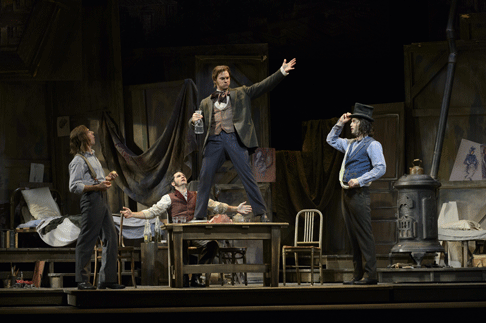 (Left to Right) Phillip Addis as Marcello, Eric Margiore as Rodolfo, Cameron McPhail as Schaunard and Tom Corbeil as Colline [Photo by Chris Hutcheson]
(Left to Right) Phillip Addis as Marcello, Eric Margiore as Rodolfo, Cameron McPhail as Schaunard and Tom Corbeil as Colline [Photo by Chris Hutcheson]
But what a score this is! And what a splendid, virtuoso performance Music Director Johannes Debus drew from his.fine orchestra. Whether in ensemble or solo passages, the instrumentalists proved they are among the top tier of pit orchestras with a reading that was thrilling in its detail and passion. Maestro Debus continues to prove he can wring consummate music-making from his assembled forces while also imbuing the effect with a jolting theatrical charge.
John Caird’s direction of La bohème was constantly inventive yet truthfully presented. Mr. Caird managed to develop wonderfully complex characters with his superb cast, yielding performances rich with subtext and personal history. I will not soon forget the entrance he devised for Mimi, having her faint to the floor at the first musical opportunity, reducing the stymied Rodolfo to dipping his fingers into a jug and lamely flicking water on the girl’s face in an attempt to revive her. The director was full of happy surprises all evening long.
The sprawling Café Momus scene was rife with detail all the while the stage traffic was exceedingly well-managed. The excellent children’s chorus was especially well used and the bustle eventually settled down to place the principals stage right where the action was particularly well-focused. Having Musetta sit almost back to back with Marcello allowed her to naughtily tease him with some rather steamy pawing and groping during Quando m’en vo. On the three instrumental stings just before she begins that aria, she snapped her nail on her wine glass to get everyone’s attention, prompting appreciative chuckles from the audience that such overly familiar material could seem new again.
Much of what Mr. Caird was able to achieve must have been owing to a fertile collaborative process with David Farley who devised an ingenious set design. The look of this production was based on the concept of using collages of Marcello’s paintings to create walls, roofs, doors. . .well pretty much everything. With a nod to Toulouse Lautrec the act curtain is one great canvas that prominently features two women, presumably Mimi and Musetta, as muses (or distractions).
Marcello is often painting, usually discovered in action behind the scrim at the start of scenes, stopping to make a sketch now and again, even documenting Mimi’s death. Rodolfo, too, is compelled to write, subtly pulling out a small diary periodically to record some observation or emotion for future use. The constant ‘creative’ impulse of the four bohemians made for relationships of unusual depth. This is not to say that the buoyant horseplay and camaraderie were in any way muted. The dancing and fencing in Act Four was delightfully impulsive and seemed breathlessly impromptu, perfectly setting up the sure-fire moment when Musetta bursts through the door.
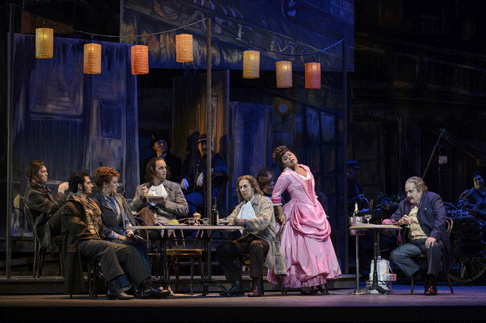 A scene from La Bohème [Photo by Chris Hutcheson]
A scene from La Bohème [Photo by Chris Hutcheson]
It is a testament to the stagecraft that Ce'è Mimí... was so intense that it chilled even those of us who knew what came next. Nor was the famous ending any less well-served. With beautiful stage pictures unfolding and an inevitability about the interplay and movement, the team crafted an unforgettable final impression, Rodolfo, his back almost to us, pulling the deceased Mimi into his arms, clasping her tight and keening, rocking her back and forth, back and forth. . .well it doesn’t get any better than this.
None of this stagecraft would have mattered, had not the cast been up to the task. It almost seemed as though the arrival of a new era of thrilling bohemian proponents had been announced with this performance. I might have to hearken back to Ricciarelli and Carreras at the Met, or perhaps Scotto and Pavarotti to convey some sense of ‘occasion’ to match the achievements of Michael Fabiano (Rodolfo) and Joyce El-Khoury (Mimi).
Mr. Fabiano has the youthful demeanor and the squillo in his throbbing tenor to encompass all of the role’s demands. The voice is responsive, well-controlled, all the while it soars to impassioned heights. He could well be the tenor we have been waiting for in this repertoire. Temperamentally, he is perfectly suited to the impetuous poet, and there was a palpable chemistry with his Mimi. For her part, the lovely Ms. El-Khoury has all the superlatively detailed interpretive skills of Scotto, with a luminous, meaty lyric voice that “spoke” at all registers and volumes. She could spin out high-lying phrases of unearthly beauty, unfold sustained legato passages of unerring warmth, and yet convey the serenity and placidity of a humble seamstress with well modulated parlando..
Simone Osborne had a field day as the willful Musetta, and her substantial, pointed singing was far more than the yipping dog of a caricature that one sometimes encounters. Her famous aria was dispatched with sassy intent to be sure, but it also had a sensual, languorous quality that we found (like Marcello) impossible to resist. Phillip Addis’s resonant, solid baritone served Marcello well, and his rather sober presence and seriousness of purpose proved a grounded balance to his fickle love interest. Mssrs. Addis and Fabiano wrung every bit of heartfelt pathos out of their Act Four duet and they blended seamlessly.
Tom Corbeil once again did fine work all night as Colline, and his smooth bass-baritone was well-deployed to gift us with a meaningful Coat Aria. Ensemble Studio’s Cameron McPhail showed off a round and glowing bass as Schaunard. In the dual roles of Benoit and Alcindoro, Thomas Hammons was uncommonly fine, offering well-vocalized, highly individualized portrayals that were commendably long on nuance and short on affected bluster. Mr. Hammons’ work was a model of excellence in comprimario playing, presenting real characters who also just so happen to be funny.
In the pit, Carlo Rizzi presided over every bar of Puccini’s masterpiece with consummate skill. There was not one orchestral effect that did not make its mark, no moment that was not lovingly melded into the whole, no musical phrasing that was not carefully judged for maximum impact. There was a wonderful elasticity and breadth to the proceeding when needed, but also excellent forward motion to keep the whole performance unfolding with inevitability and dramatic purpose.
James Sohre
Casts and production information:
Peter Grimes
Peter Grimes: Ben Heppner; Ellen Orford: Ileana Montalbetti; Balstrode: Alan Held; Auntie: Jill Grove; Niece 1: Claire de Sévigné; Niece 2: Danielle MacMillan; Bob Boles: Roger Honeywell; Ned Keene: Peter Barrett; Swallow: Tom Corbeil; Mrs. Sedley: Judith Christin; Dr. Crabbe: Thomas Hauff; Rev. Horace Adams: Owen McCausland; Hobson: Robert Pomakov; John: Jakob Janutka; Conductor: Johannes Debus; Director: Neil Armfield; Revival Director: Denni Sayers; Set Design: Ralph Myers; Costume Design: Tess Schofield; Lighting Design: Damien Cooper (recreated by Wendy Greenwood); Chorus Master: Sandra Horst
La bohème
Mimì: Joyce El-Khoury; Musetta: Simone Osborne; Rodolfo: Michael Fabiano; Marcello: Phillip Addis; Colline: Tom Corbeil; Schaunard: Cameron McPhail; Benoit/:Alcindoro: Thomas Hammons; Parpignol: Owen McCausland; Customs House Sergeant: Clarence Frazer; Customs Officer: Gordon Bintner; Conductor: Carlo Rizzi; Director: John Caird; Set & Costume Design: David Farley; Lighting Designer: Michael James Clark; Chorus Master: Sandra Horst
image=http://www.operatoday.com/PG_Toronto_2013_01.gif
image_description=Ben Heppner as Peter Grimes [Photo by Michael Cooper]
product=yes
product_title=“T” as in “Terrific Toronto”
product_by=A review by James Sohre
product_id=Above: Ben Heppner as Peter Grimes
Except as otherwise indicated, photos by Michael Cooper
November 4, 2013
La damnation de Faust: LSO/ Gergiev
By Stephen Jay-Taylor [Opera Britannia, 4 November 2013]
If things had gone according to plan, this would have been the second outing for Berlioz’s trail-blazing “dramatic legend” given by a major London orchestra at the start of the 2013/14 concert season.
Daniel Barenboim to step down from La Scala two years early
[Gramophone, 29 October 2013]
The conductor relinquishes his post as music director in 2015 following unconfirmed reports that Riccardo Chailly will succeed him
November 3, 2013
Listen to Yourself: A Conversation with Christa Ludwig
By Dean Southern [Classical Singer, November 2013]
On a July morning, in the beautiful Klimt-inspired Jugdenstil breakfast room of the Hotel Wiesler in Graz, Austria, I sat with Kammersängerin Christa Ludwig, one of the most notable vocal artists of the last half of the 20th century. Ludwig’s long and celebrated career encompassed both mezzo-soprano and dramatic soprano roles, as well as concert and Lieder performances, all of which are richly documented in her extensive discography.
November 2, 2013
Two Boys at the Brave New Met
Along with controversial new productions of pre 20th century works, the company recently performed John Adams’ Dr. Atomic, Thomas Adès’ The Tempest and this season it is presenting its first commissioned opera, Nico Muhly’s Two Boys.
And you can’t have had the most casual relationship with opera without having heard or read about the Muhly work. In fact, you needn’t have had any idea that opera even exists as an art form, to have heard about it. Its libretto, based on an incident of Internet deception which took place in Manchester, England, had a Page One murky resonance recently for Americans in the romantic hoax perpetrated on San Diego Chargers’ linebacker Manti Te’o. To attract the young, hip and internet knowledgeable to the premiere, the Met advertised in real and virtual nooks and crannies of New York that had never seen opera ads, previews or posters before.
Two Boys is the first fruit of the Met/Lincoln Center Theater New Works Program, a commissioning project instituted in 2006 in which composers are paired with librettists, and eventually directors and designers, to develop new works for the two theaters. It’s a long, laborious process, which includes repeated workshops. For his first full length opera, Muhly was paired with a veteran writer Craig Lucas and producer Bartlett Sher. Yet even Two Boys’, world premier at the English National Opera in 2011, turned out to be a workshop. Since then the three have made numerous revisions of the libretto, music and staging. Fortunately the black clad spiky haired Muhly, now 32, and a prolific composer of classical works, as well as of pop, and movie music, is cooperatively inclined. “I’m so happy to change stuff “ he is quoted as saying, “I think most operas after their first performance get revised, since the beginning of time."
The libretto of Two Boys is presented as a police drama taking place in an industrial British city. Black and white cam tapes reveal 16 year old Brian, stabbing 13 year old Jake, and leaving him for dead. The task of unraveling how and why this happened is left to Anne Strawson, an oddly dense career detective, who strangely knows nothing about computers, and who is responsible for her mother’s care. It is a chance remark by her mother, which eventually leads her to understand the dimensions of the crime. Eventually, Strawson gets Brian to reveal an almost unbelievable story of the various people he met through a chat room, who led him to commit the crime. First there is Rebecca, then her brother, Jake, Fiona, their mother’s friend and a secret agent, the sinister gardener named Peter, all of whom drive him to the crime. They turn out to be the names of real people, recreated as inventions by the 13 year-old victim, the real Jake, who has engineered his own death.
The gist of the opera is in the manner in which these scenes unfold to reveal the characters’ backgrounds, as well as their real and imaginary encounters. “I go to school, I do my homework, I eat supper,” Brian tells Strawson as we follow his first tentative approach to a chat room, and his increasingly enticing, entangling, relationships with young Rebecca, seductive Fiona, frightening Peter, and finally with Jake himself. In Strawson’s first scene with her mother, we see her mother nag her about neglecting her appearance, and learn that in order to pursue her career, she had given up an infant son, who would now be Brian’s age.
Two Boys, with worried looking Strawson, conniving Jake, befuddled Brian, and an anonymous horde of chat room cohorts seeking they know not what of the Internet, is a dark tale with an undercurrent of delirium. Bartlett Sher’s production and Nico Muhly’s music capture its moods perfectly. Grayish blank panels shift from Strawson’s home to Brian’s, to Jake’s hospital room, with the silent rapidity of movie or television screens -and alternately serve as projection screens for wildly repetitive iterations of chat room dialogue. Textual representations and droning choral repetitions of fragments of internet “speech” such as “r u there?” appear repeatedly and fade, in flashing sometimes ominous animations created by 59 Productions. Muhly’s intriguing rhythmic orchestral patterns and striking harmonies, underline the delirium of the chatters’ amorphous yearnings. Costumes are drab and dull except for those imaginary characters, who seem real to Brian. Hofesh Shechter’s choreography of the chat room scenes illuminates the dull lives of the participants and the lurid possibilities offered by the Internet, as twisting, writhing dancers, perhaps portending evil, weave in out of the ranks of the massed “chatters’’.
In a brilliantly contrasting scene, ominous darkness gives way to peace as a stained glass window glows quietly in an Anglican Church. Here as the congregants sing and Brian comes face to face with the real Jake for the first time, Muhly’s music glows as well, with a kind of peace and limpidity. “Music of the English Renaissance and Tudor Music has been a cantus firmus through everything I do, not just musically, but also as a sort of philosophy of how to make music and think of yourself as a composer,” Muhly said in an interview.
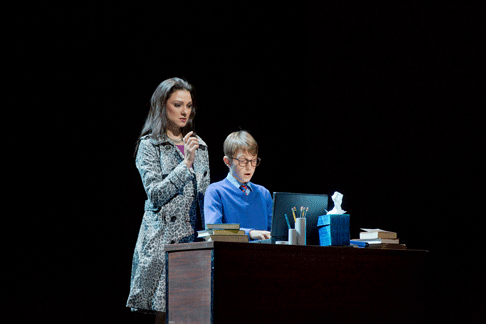 Sandra Piques Eddy as Fiona and Andrew Pulver as the Boy soprano
Sandra Piques Eddy as Fiona and Andrew Pulver as the Boy soprano
Muhly’s large, imaginative musical palette includes pacing of vocal lines to understandable natural speech, and remarkable choral music. "Shimmering" is the word one most often encounters in reviews of Muhly’s chorales. There is a kind of dry Britten-like lyricism in his melodic writing, particularly in Strawson’s concluding aria, and intermittent patches of minimalism throughout the work, which Muhly’s mentor, Philip Glass, prefers to call "repetitively structured" music.
The Met gave us an excellent cast. Mezzo-soprano, Alice Coote, who made a moving Anne Strawson, Paul Appleby, a youthful 30 year old tenor, whose acting and singing were convincing as 16 year old Brian, and Andrew Pulver, an 11 year old boy soprano, coolly in command of his role as Jake. Their supporting cast was equally memorable.
Nico Muhly has written a potentially haunting opera — yet one that does not haunt enough — that neither seeks, nor achieves a climax, and whose passionless protagonists accede too easily to death and loss and pain.
One wonders whether Muhly or librettist Craig Lucas knew their characters well enough to understand the powerful emotions that drove two children to suicide and murder, and trapped a young police woman responsible for the care of a nagging mother without any visible disabilities, into a life of sexual and emotional repression.
Nevertheless, Two Boys gives reason to believe that Nico Muhly’s next opera — it has already been commissioned by the Met — will haunt viewers long after its last curtain drops.
And yes, however the Met did it, the audience at the opera’s second performance, which I attended, was young, hip and enthusiastic, particularly when the beaming composer appeared to acknowledge its cheers.
Estelle Gilson
Cast and production information:
Brian: Paul Appleby; Anne Strawson:Alice Coote; Cynthia, Jake’s mother: Caitlin Lynch; Rebecca: Jennifer Zetlan; Brian’s mother: Maria Zifchak; 13 year old Jake: Andrew Pulver; Anne’s Mum: Judith Forst; Fiona: Sandra Piques Eddy; Jake: Christopher Bolduc; Peter: Keith Miller. Conductor: David Richardson. Production: Bartlett Sher. Set Designer: Michael Yeargan. Costume Designer: Catherine Zuber. Lighting Designer: Donald Holder. Animation: 59 Productions. Choreographer: Hofesh Shechter.
image=http://www.operatoday.com/boys_7493a.gif
image_description=Alice Coote as Anne Strawson and Paul Appleby as Brian [Photo: Ken Howard/Metropolitan Opera]
product=yes
product_title=Two Boys at the Brave New Met
product_by=A review by Estelle Gilson
product_id=Above: Alice Coote as Anne Strawson and Paul Appleby as Brian
Photos by Ken Howard/Metropolitan Opera
November 1, 2013
Wozzeck, Royal Opera
Only Marie’s small, shabby bedroom, to the front left, provide some respite from the unalleviated soullessness.
First seen in 2002, winner of an Olivier Award for Best New Opera Production in 2003, and revived in 2005, Warner’s staging asks much of its personnel. The institutional grimy white is transmuted only occasionally by a black triangular shape which descends from the flies, and by the mirrored wall onto which Wozzeck’s mysterious hallucinations are projected (lighting design, Rick Fisher); this single-set offers little assistance to the singer who must convey Wozzeck’s misery and oppression as, ever more humiliated and betrayed, his world shrinks to become a claustrophobic prison of mental confinement.
Buchner’s Wozzeck is deeply affected by the natural world, but here there are no external locales, no mists or rising suns, no eerie moonlight; the toad-stalls which so disturb Wozzeck — small, delicate rings, wondrously inscrutable beneath the arching, glittering constellations above — are here giant-sized, contained within one of four the clinical glass tanks in which the Doctor conducts his experiments.
In Warner’s concept we seem to be within Wozzeck’s own mind — a mind which is already unhinged at the start of the opera. It’s certainly the case that by the end of Berg’s opera we see, and hear, the world through Wozzeck’s perspective: the lullaby which the bar maid sings to Wozzeck when he stumbles into the tavern after his horrific act; the deafening, hysterical cries of the crowd, ‘Blood! Blood!’, when his crime is discovered; the rising parallel scales as Wozzeck sinks to his depths of the pool of water in which he strives in vain to rinse the bloodstains from his hands — all of these musical details present us with a world seen through Wozzeck’s eyes, a world distorted by his own obsessions and fears. But, we need the context to appreciate this warped subjective vision. The grotesques with which Berg presents us are not simply caricatures, or abstractions of cruelty, they are representatives of the selfish, heartless ruling class, one that subjugates the less fortunate, forcing them into financial and moral impoverishment. This is the society that defeats the humble Wozzeck, a member of the oppressed under-class, who is driven to commit murder by his poverty and powerless.
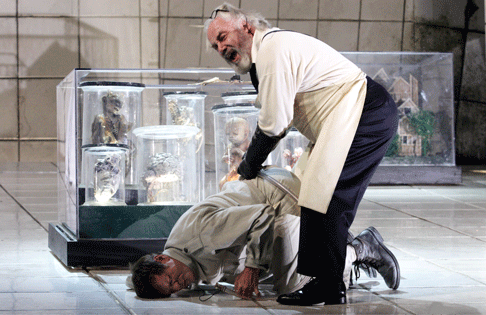 Simon Keenlyside as Wozzeck and John Tomlinson as Doctor
Simon Keenlyside as Wozzeck and John Tomlinson as Doctor
Baritone Simon Keenlyside is an experienced veteran in the title role - this year alone he has already performed the part in Vienna, Madrid and Munich - but in some ways he might be thought too physically suave and composed to convince as the mentally ravaged soldier. But, Keenlyside showed us the psychological rawness while maintaining the essence of Wozzeck’s humanity, the beauty of the vocal lines drawing us into his confusion, the variations of colour and nuance revealing the depth of that bewilderment. The lightness of his baritone contrasted effectively with the Doctor’s deep bass, emphasising further Wozzeck’s defencelessness; progressively dehumanised, rendered ever more inarticulate, Keenlyside evoked a powerful sense of Grimes-like alienation from those around him. His interactions with his child, played with acuity by Sebastian Wright, were painfully poignant.
Keenlyside’s voice is essentially lyrical and herein lies a small misgiving though, for the eloquence of the vocal lines was sometimes at odds with the primitive brutality of the experience. The baritone, in common with virtually all the cast, doesn’t make much of the Sprechstimme but some vocal ‘roughness’ is needed to project the tragedy of this “psychotic anti-hero” (Derek Jarman). The contrast of lyrical and half-spoken utterance can be deeply expressive, as in the drowning scene in Act 3 when, as he desperately searches for the murder weapon, Wozzeck’s Sprechstimme ‘All is still and dead’ contrasts with his ferocious shouts of ‘Murder’. ‘Who cried?’ he wonders, then realises that it was he himself who spoke; the different vocal idioms reveal a destructive fragmentation of both body and psyche, one which is made more poignant when Wozzeck then sings tenderly over Marie’s dead body: ‘Marie! What is that crimson necklace you’re wearing? Was that well-earned, or sinful, just like the earrings?’ Has he really forgotten what he has done?
Singing the role of Marie for the first time, Karita Matilla sang with typical fearlessness and passion. However, though dressed in a cheap floral frock and hiding her own blond hair beneath a grubby brown wig, Matilla perhaps retained rather too much of her natural poise and grace, her tone too consistently sensuous and alluring for a rough and ready adulteress. The silky high notes in her prayer scene were truly beautiful though, and in Act 3 Matilla’s declamations were full of urgency and anguish.
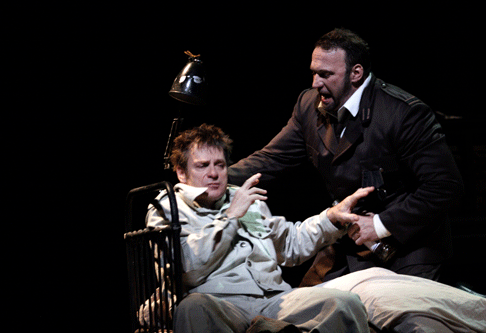 Simon Keenlyside as Wozzeck and Endrik Wottrich as Drum Major
Simon Keenlyside as Wozzeck and Endrik Wottrich as Drum Major
John Tomlinson’s Doctor was no cartoon-esque ‘mad scientist’, but rather a cruel, callous manipulator, for whom each and every man and woman is a potential medical specimen, ripe for merciless experiment, no more deserving of compassion that a shark in formaldehyde. Tomlinson acted the part of the obsessive maniac superbly, although the vocal performance was a little uneven.
The Doctor’s hideous duet with the Captain, Gerhard Siegel, was appropriately ghastly, a masterpiece of caricature, the magnification of abnormality verging on madness which they use to control and exploit Wozzeck. Siegel relished the Captain’s idiocies, formidably establishing his moral vacuity in the opening scene with Wozzeck, his tenor muscular and strong as he rambled interminably about his superior intellect and status, spouting empty-headed philosophical sound-bites.
Endrik Wottrich’s Drum Major sounded a little strained, but his steely tone suited the callousness of the abusive lecher, and he acted well. John Easterlin might have made more impact as Andres, Wozzeck’s companion; his folky huntsman’s song in Scene 2 should ideally contrast more strikingly with Wozzeck’s eerie Sprechstimme utterances, indicating the schism that separates these supposed friends. Allison Cook (Margret) and Robin Tritschler (Half-Wit) performed well in their cameo roles, and Jeremy White and Grant Doyle acquitted themselves ably as the First and Second Apprentice respectively. The ROH chorus were rather genteel for a crowd of soldiers, workers and revelers who have not yet had the life spirit syringed out of them by the Doctor.
One of the most discomforting and expressively provocative aspects of this production is that the blank desolation of the sets is completely at odds with the expressive richness of Berg’s score. And, in Mark Elder’s hands this disjuncture proved even more shocking as the conductor drew orchestral lines as incisive and piercing as a surgeon’s scalpel, dissecting the complex textures with clarity and power. Grating trombone rasps, the Dantesque dancing of the double bassoon, glistening harp sweeps, ghostly double bass col legno: the musical juxtapositions of distress and beauty did much to convey the discomposing confusion of Wozzeck’s world and mind. The fierce timpani hammer blows which cry out in fury at Wozzeck’s death were earth-shattering. Superb playing by the ROH Orchestra externalised the inner anguish of those on stage, literally voicing their suffering.
At the start, Wozzeck and Marie’s child sits alone at a desk studying a book; presumably scrutinising a copy of the annotated anatomical drawing of the human head which adorns the front-drop. What knowledge does he seek? The workings of the human mind? The causes of his father’s ‘madness’? The meaning of human existence? On-stage throughout, the child observes all, even witnessing his mother have brutal sex with the Drum Major — repulsively, the latter buys the child’s silence with a grubby coin.
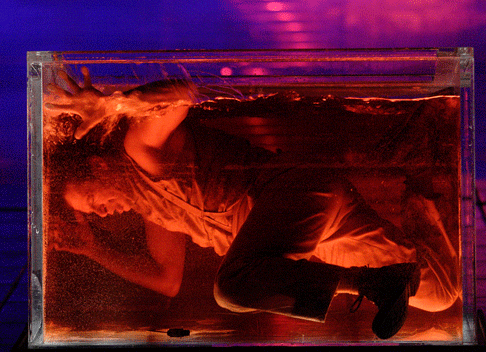 Simon Keenlyside as Wozzeck
Simon Keenlyside as Wozzeck
At the end, we wonder what the child has learned, as he stares into a tank of blood-stained water, transfixed by his father’s bloated body, while his mother’s corpse lies to the right, disregarded. Amplified voices echo from the auditorium. There are no children’s games of hopscotch, no one to speak to the child and tell him that his mother is dead; one word seems to sum up the painful drama that we have witnessed — meaninglessness. But, rather than existential disorientation, it seems to me that expressionist extremity is closer to the heart of Wozzeck. The violent distortions and heightening have an expressive purpose. At the close, should not pity and empathy accompany our feelings of horror and despair? After all, the composer’s own sympathy for his protagonist imbues the final orchestral interlude.
Warner’s staging is so remorseless that the danger is that we become impassive, shell-shocked observers; stunned and aghast yes, but not moved. Removed from his social setting and context, this Wozzeck is not a common man suffering at the hands of society and circumstance; rather, the tragedy which befalls him is determined by inner psychological compulsions, and yet he experiences no revelation and as such there is no opportunity for catharsis, through pity and fear.
That said, this is a production not to be missed. The cast perform with absolute commitment, and we are paradoxically enthralled by the dispassionate, abusive transactions depicted, even while we flinch from the horrors that the cast of soulless grotesques inflict and endure.
Claire Seymour
Further performances take place on 5th, 8th, 12th and 15th November.
Cast and production information:
Captain, Gerhard Siegel; Wozzeck, Simon Keenlyside; Andres, John Easterlin; Marie, Marita Katilla; Child, Sebastian Wright; Margret, Allison Cook; Doctor, John Tomlinson; Drum Major, Endrik Wottrich; First Apprentice, Jeremy White; Second Apprentice, Grant Doyle; Half-Wit, Robin Tritschler; Director, Keith Warner; Conductor, Mark Elder; Set designs, Stefanos Lazaridis; Costume designs, Marie-Jeanne Lecca; Lighting design, Rick Fisher; Royal Opera Chorus; Orchestra of the Royal Opera House. Royal Opera House, Covent Garden, London, Thursday 31st October 2013.
image=http://www.operatoday.com/Wozzeck_ROH_01.gif image_description=Simon Keenlyside As Wozzeck and Karita Mattila as Marie [Photo © ROH/ Catherine Ashmore] product=yes product_title=Wozzeck, Royal Opera product_by=A review by Claire Seymour product_id=Above: Simon Keenlyside As Wozzeck and Karita Mattila as MariePhotos © ROH/ Catherine Ashmore